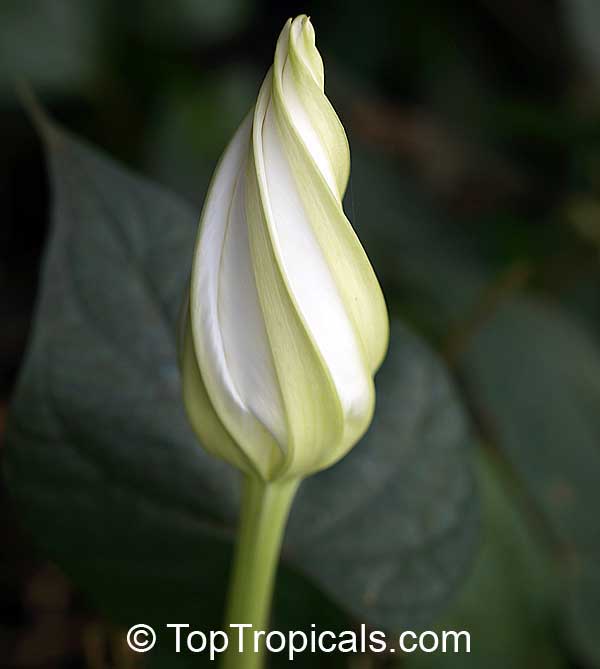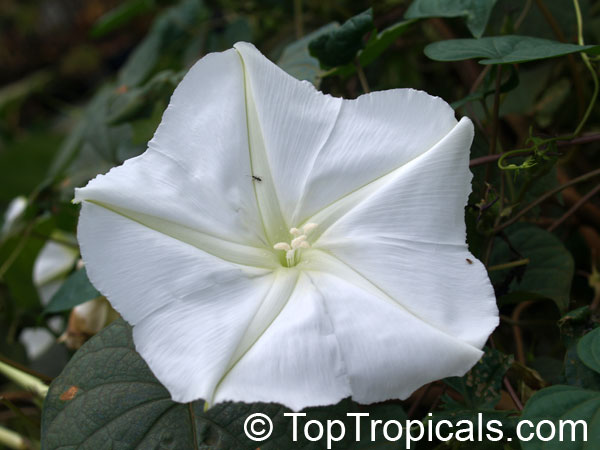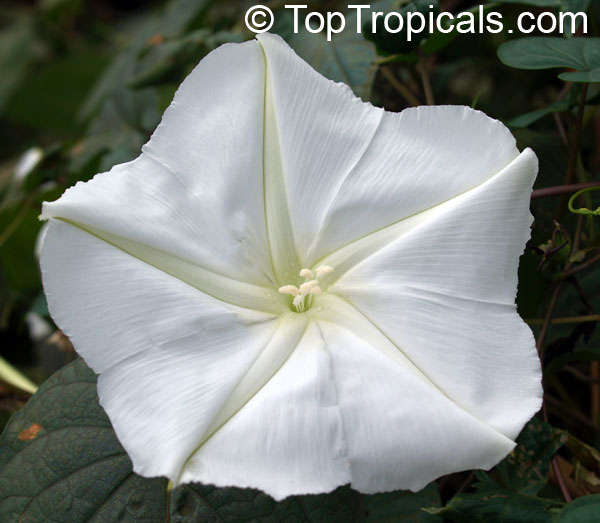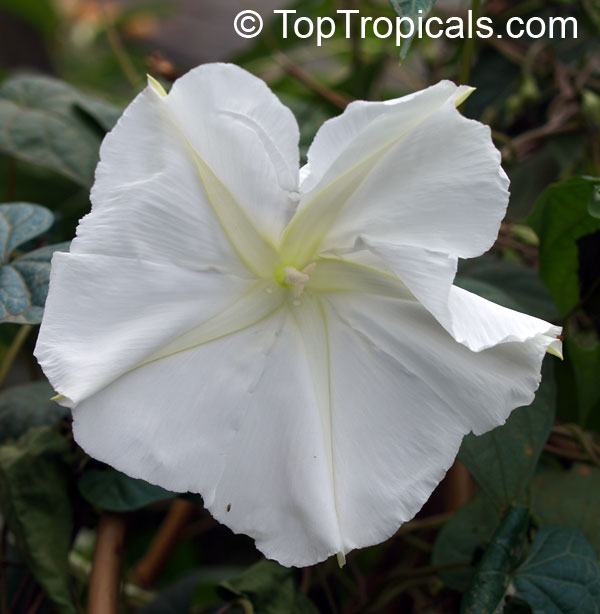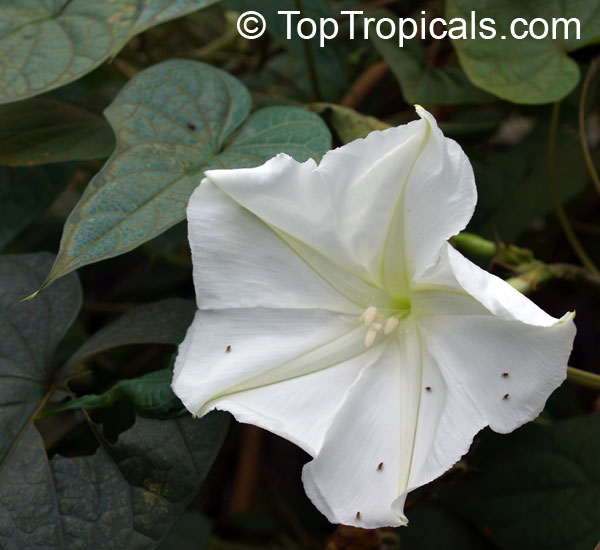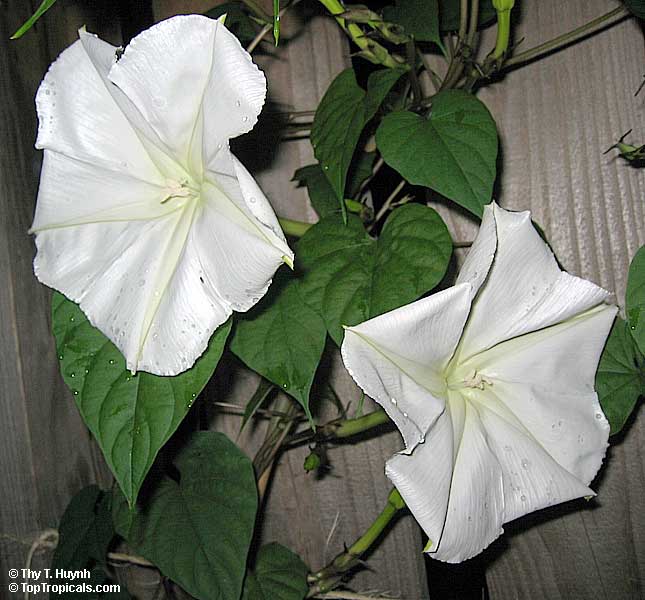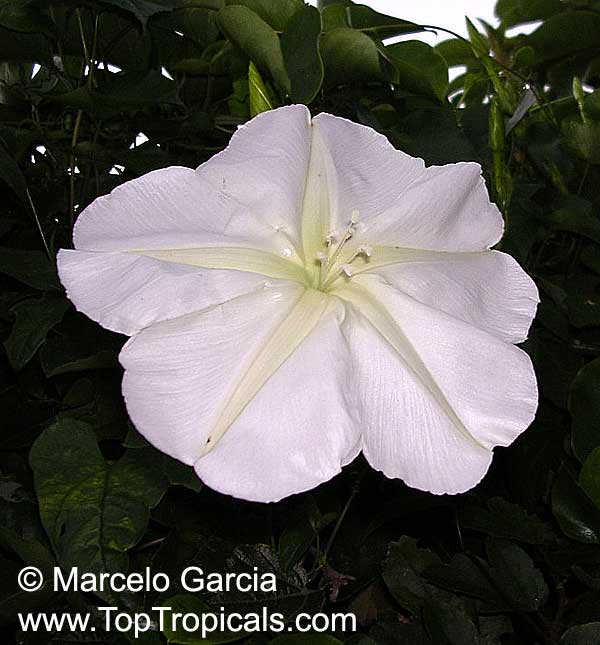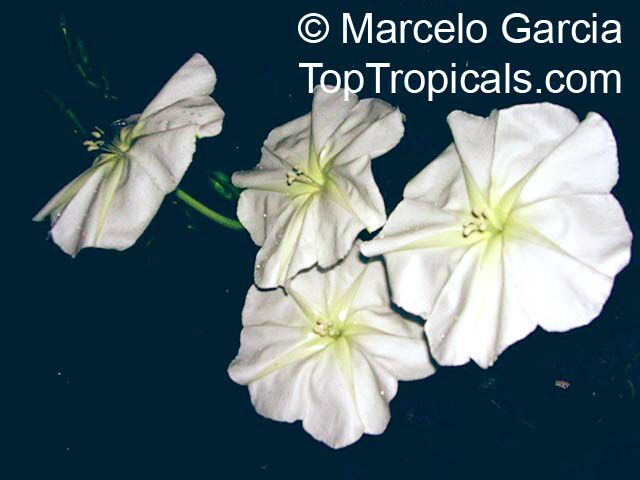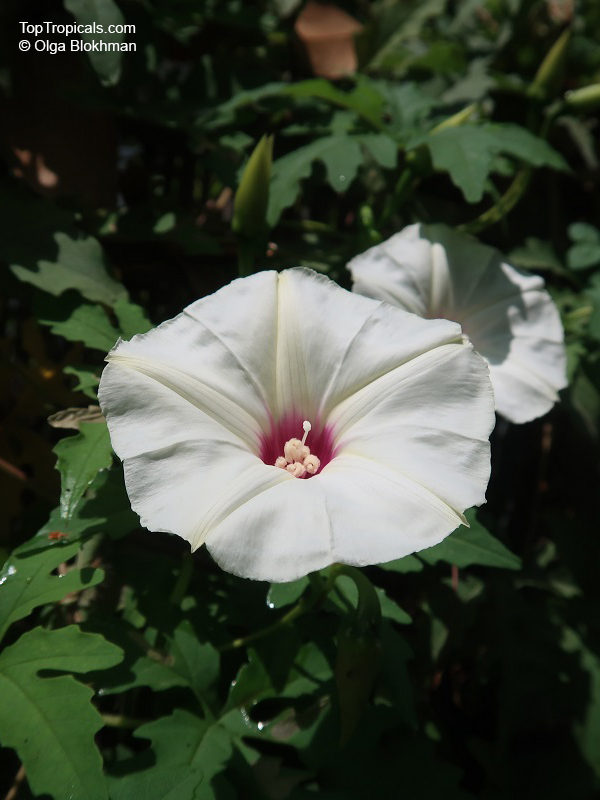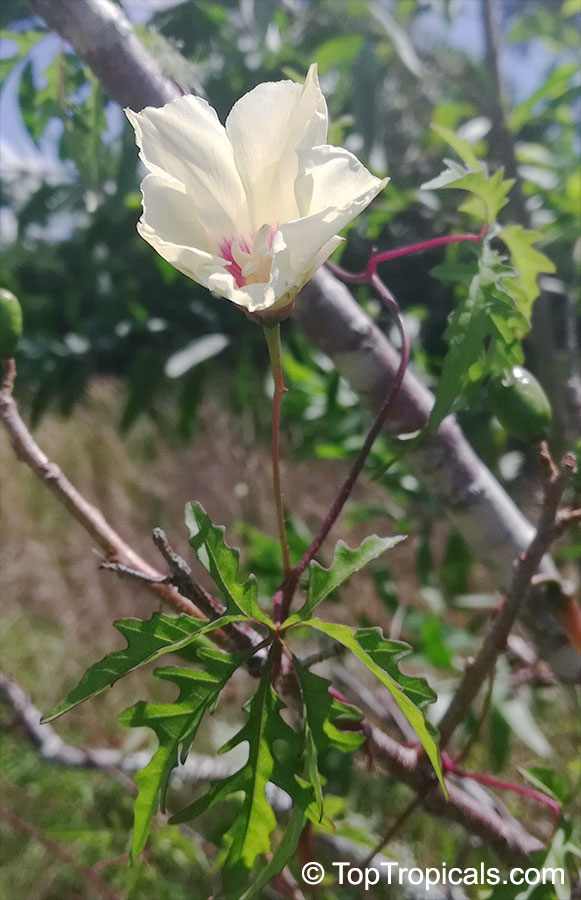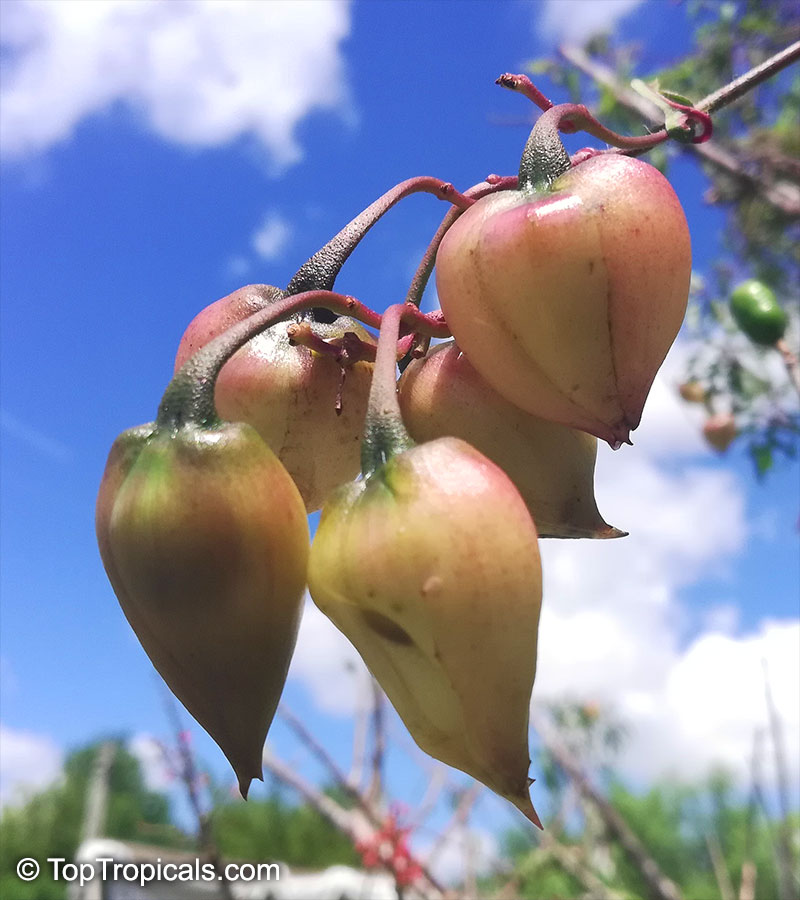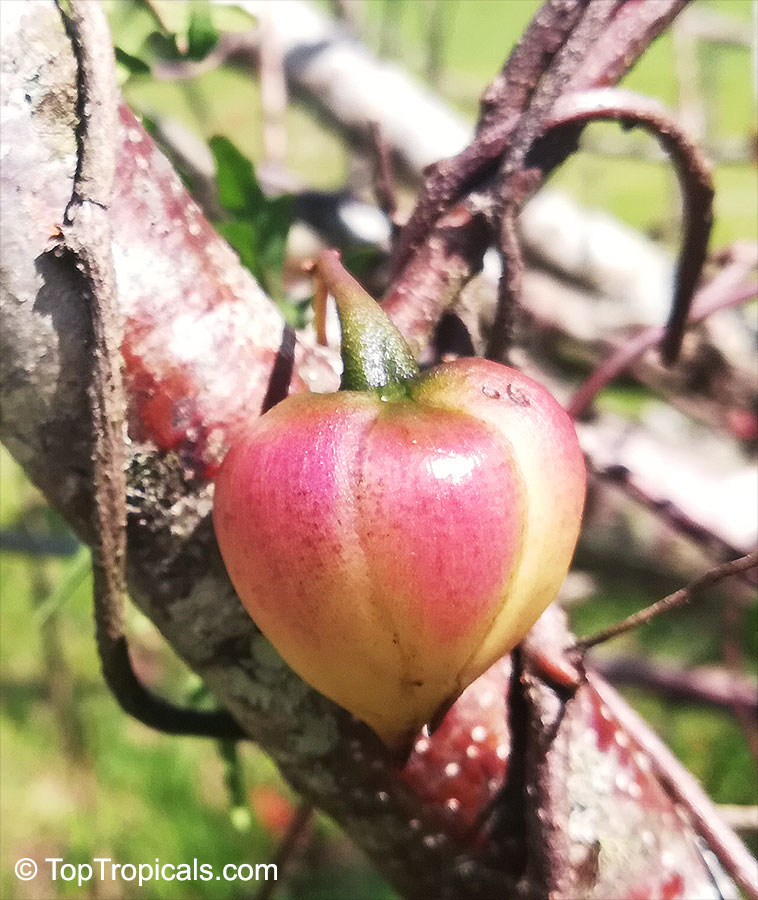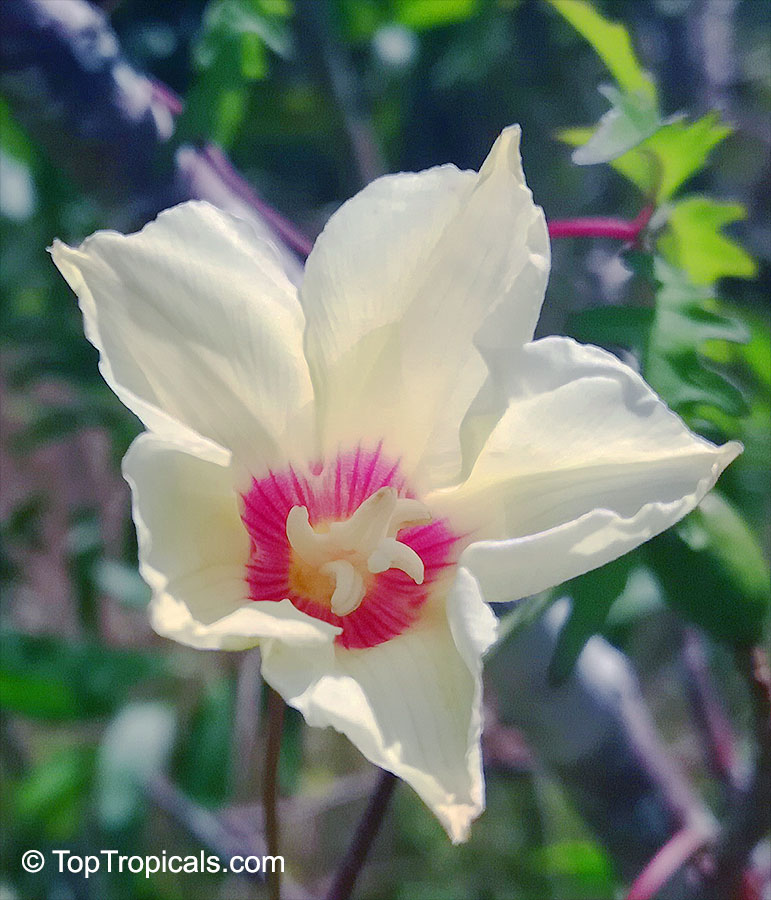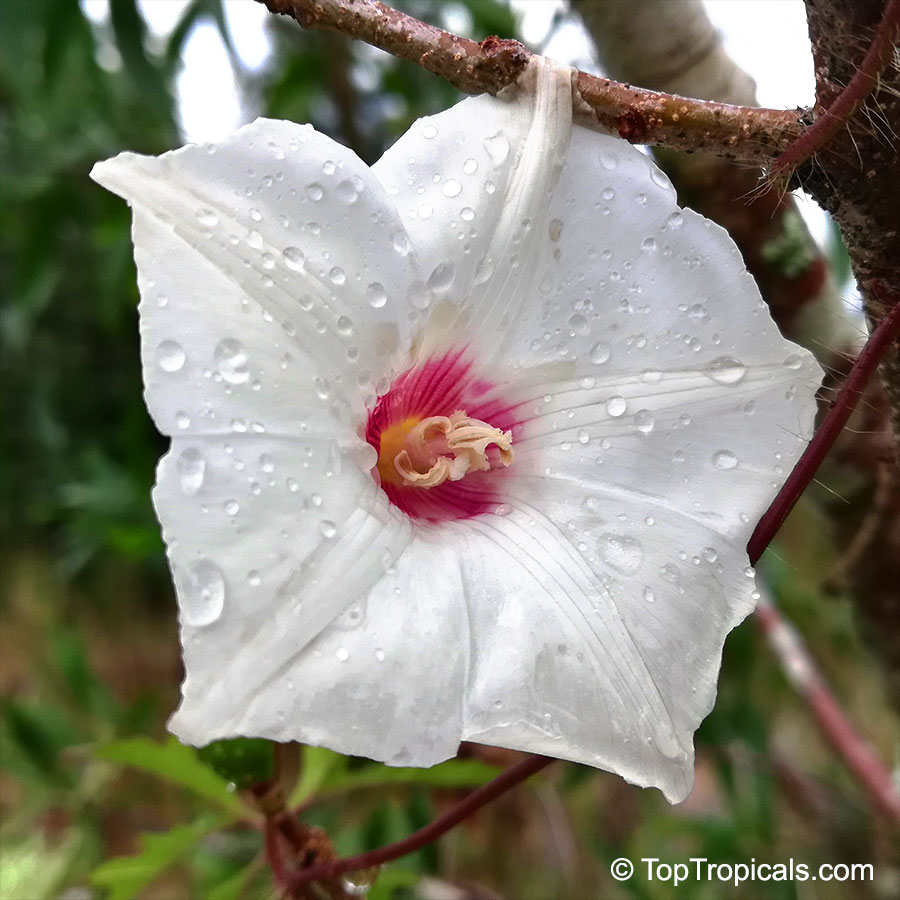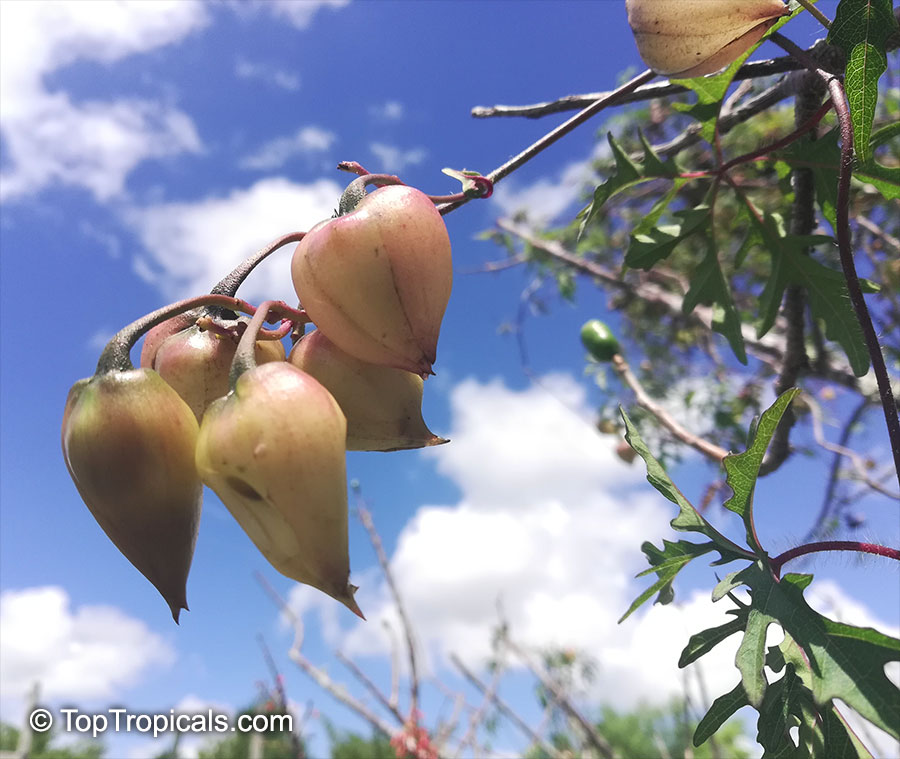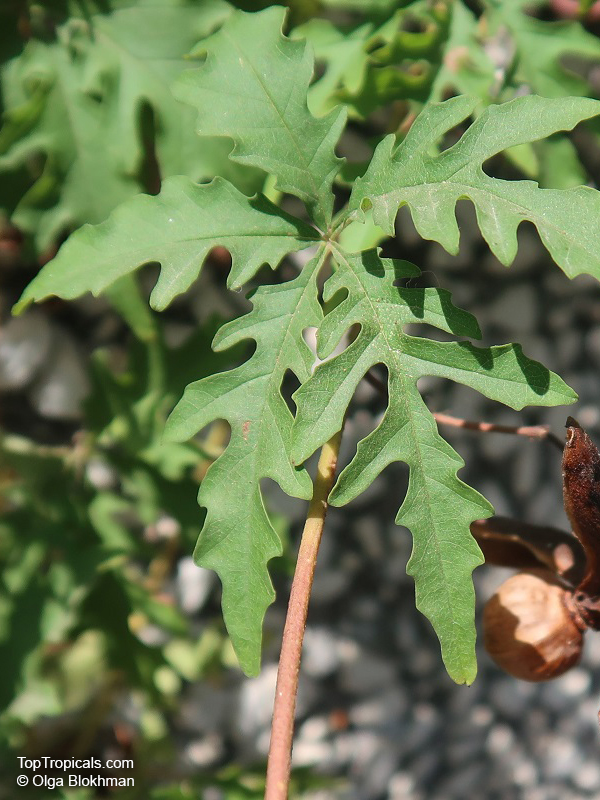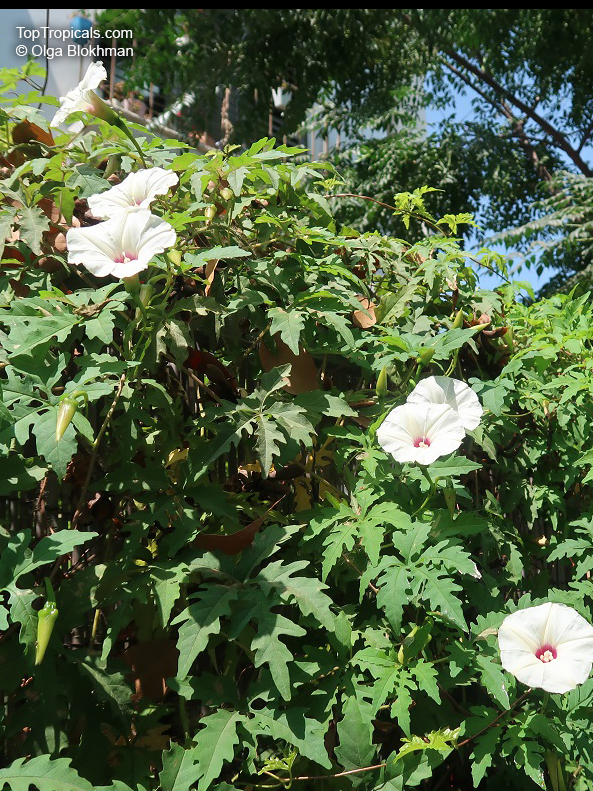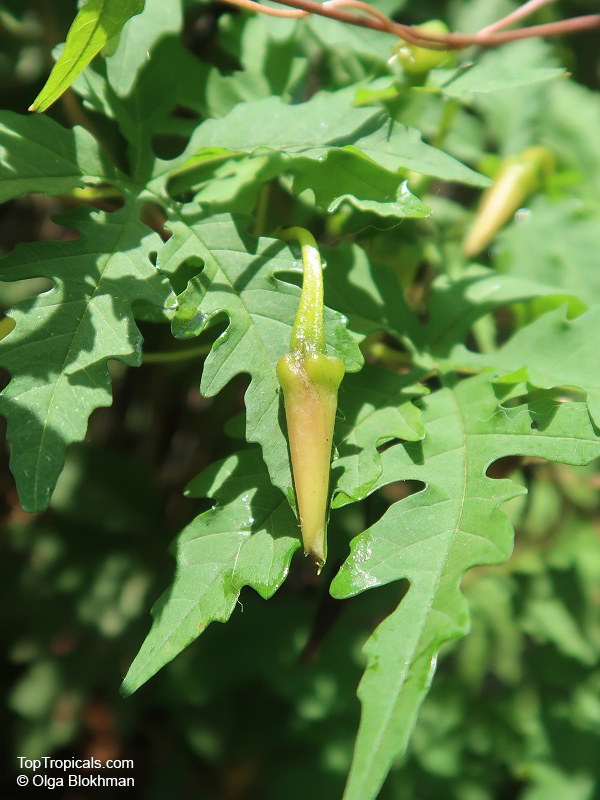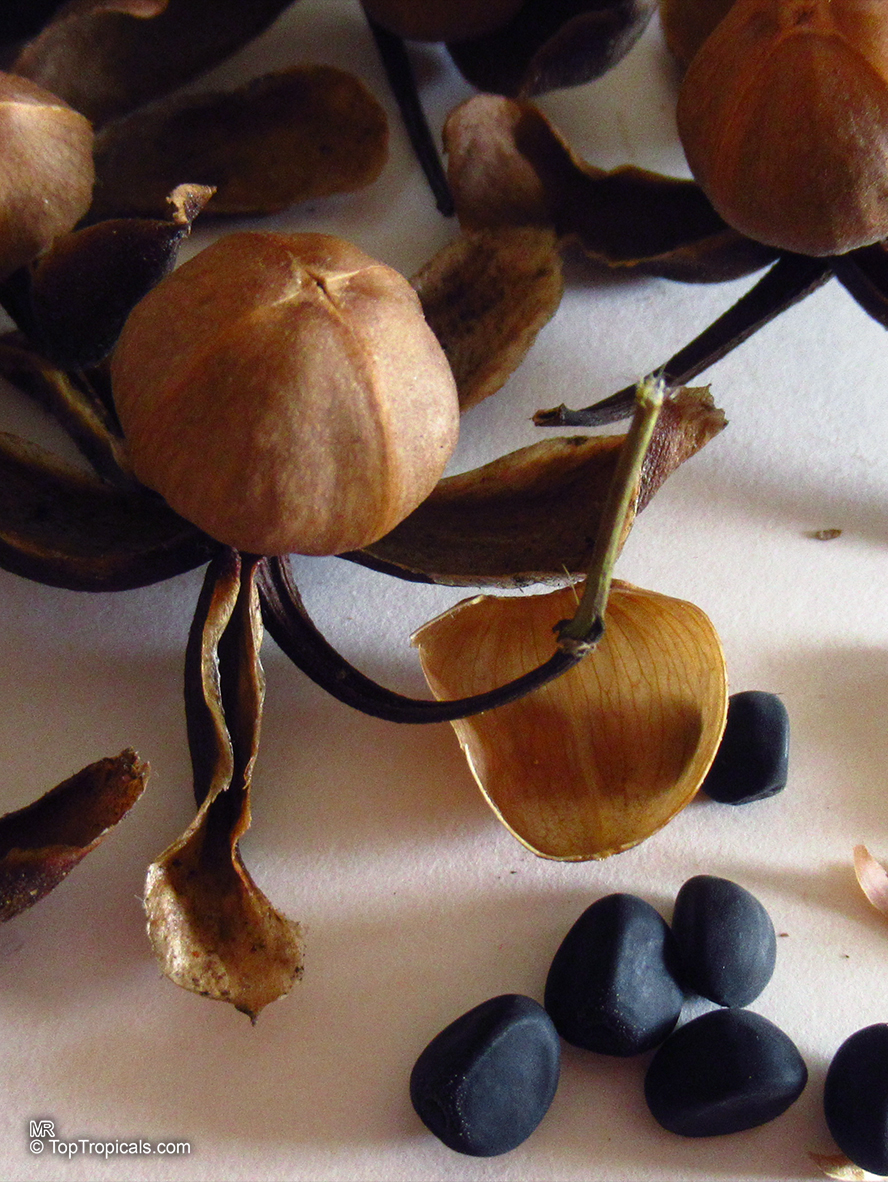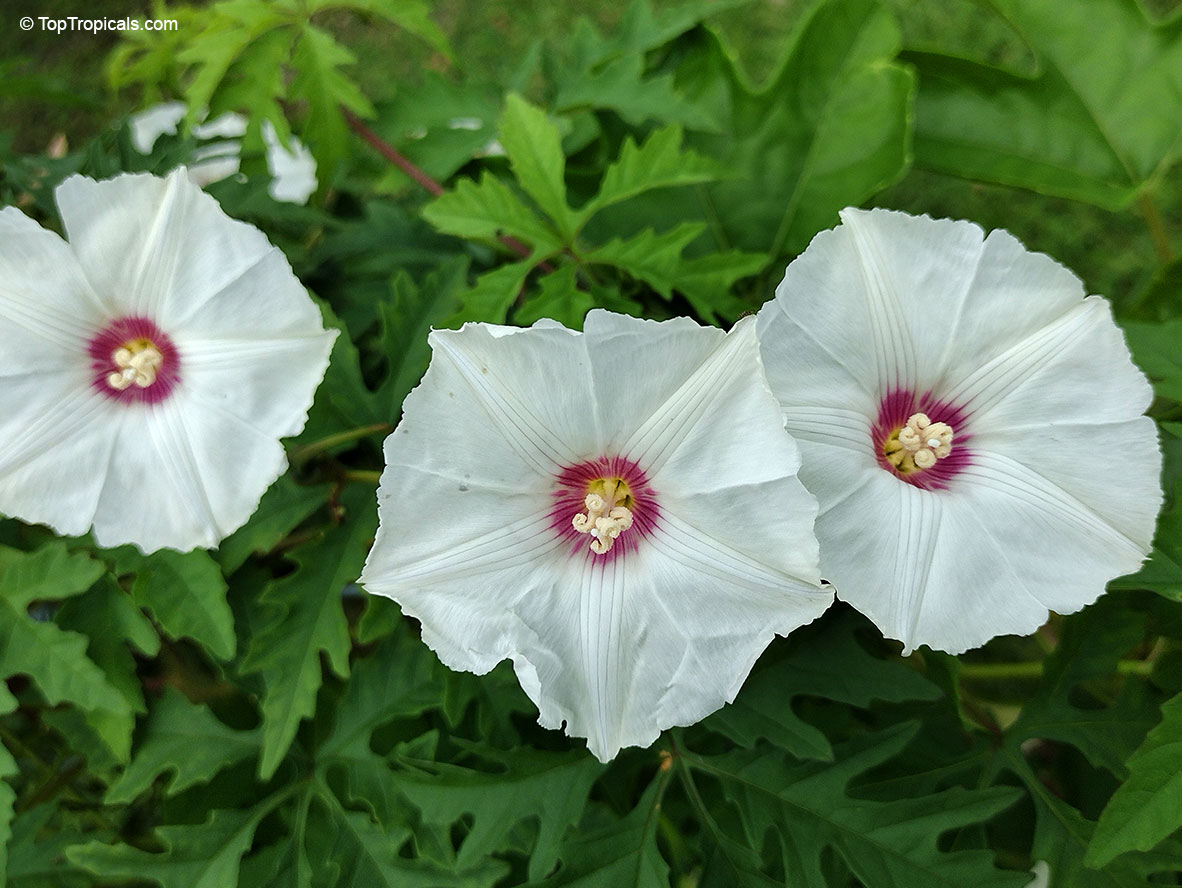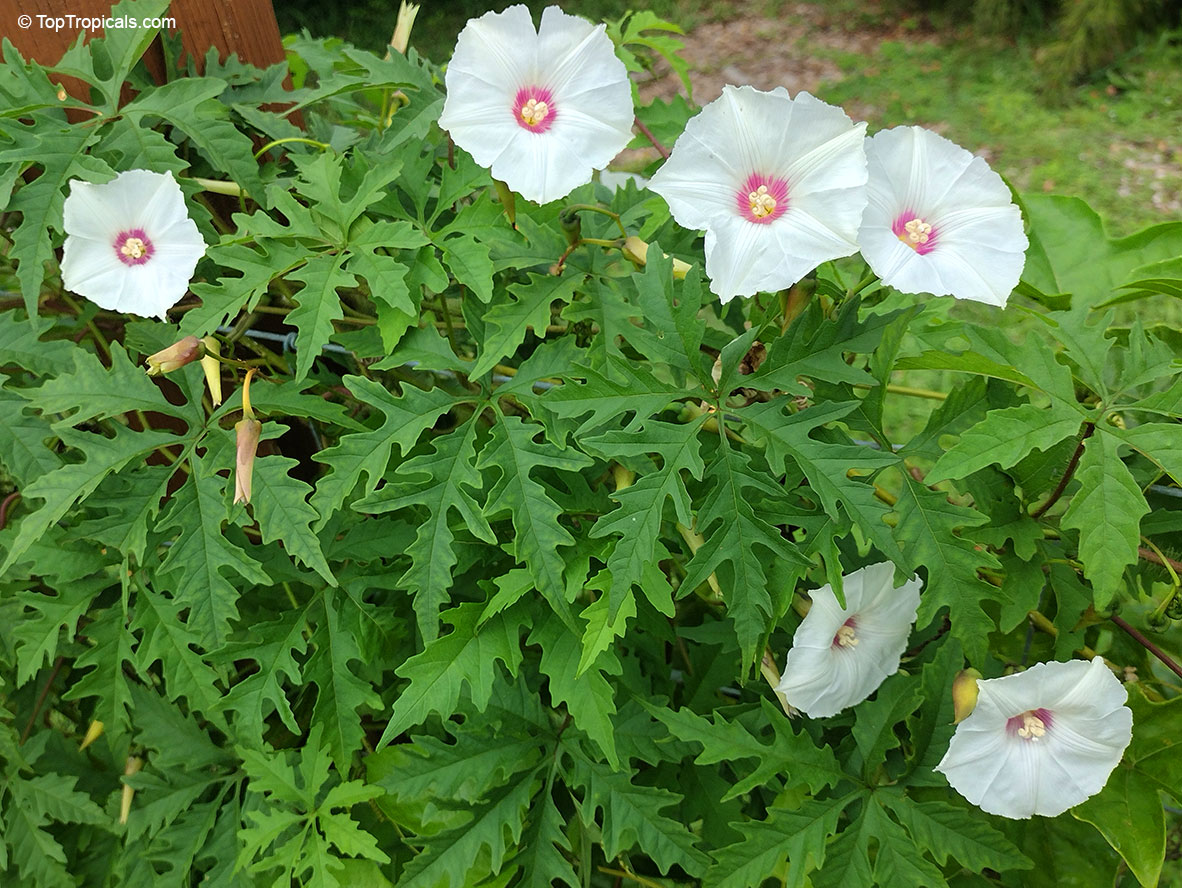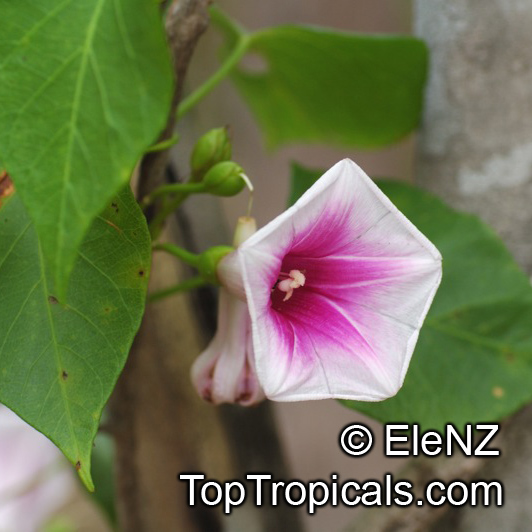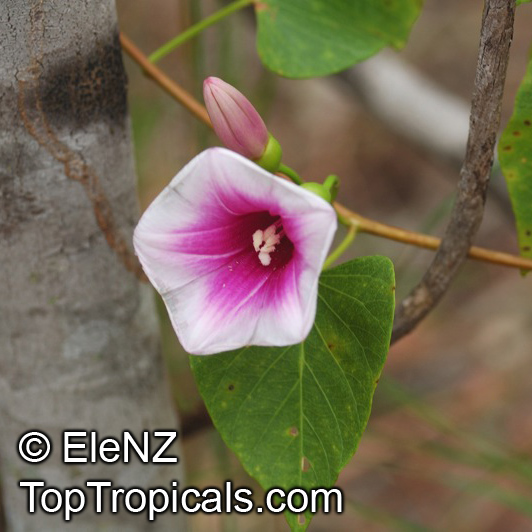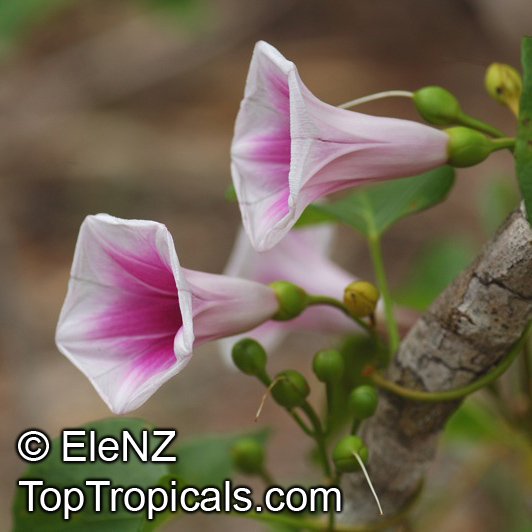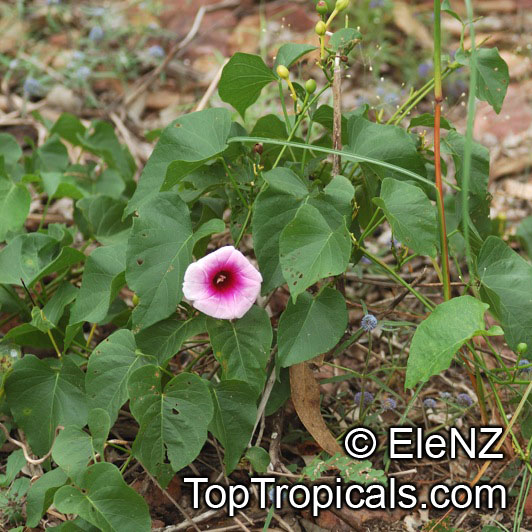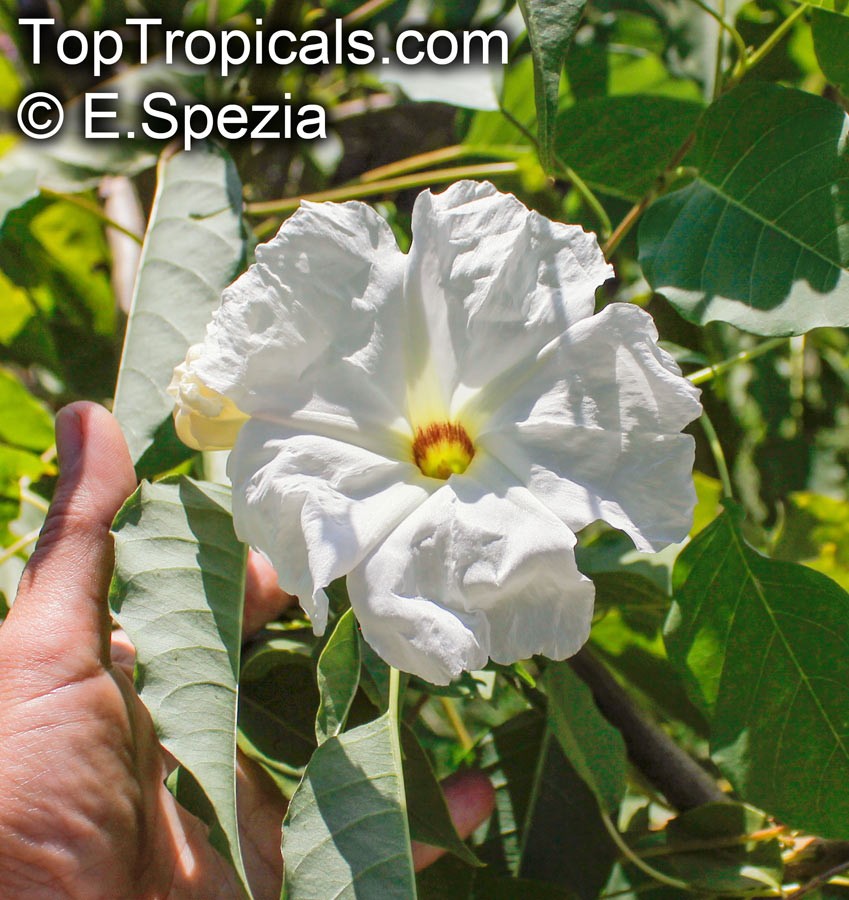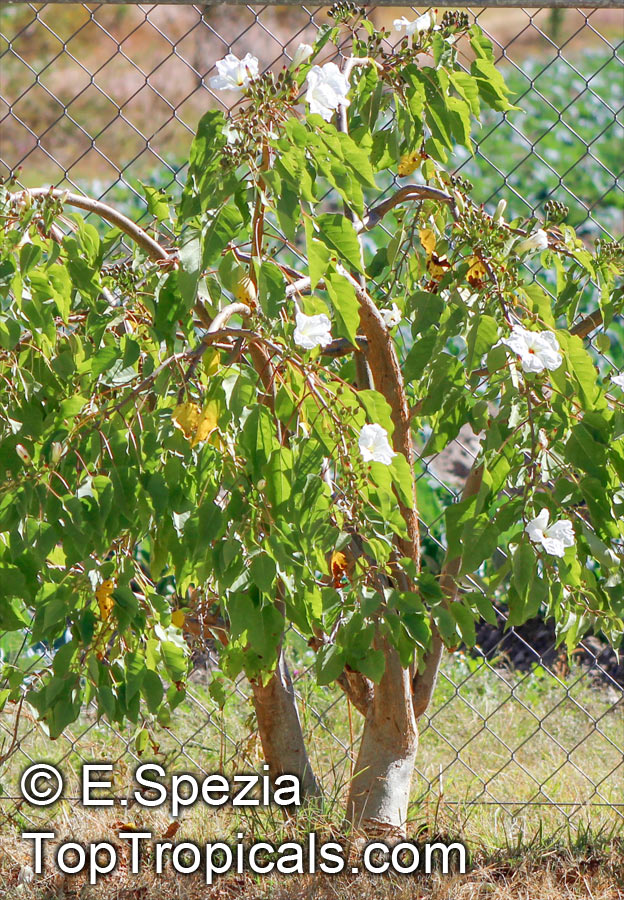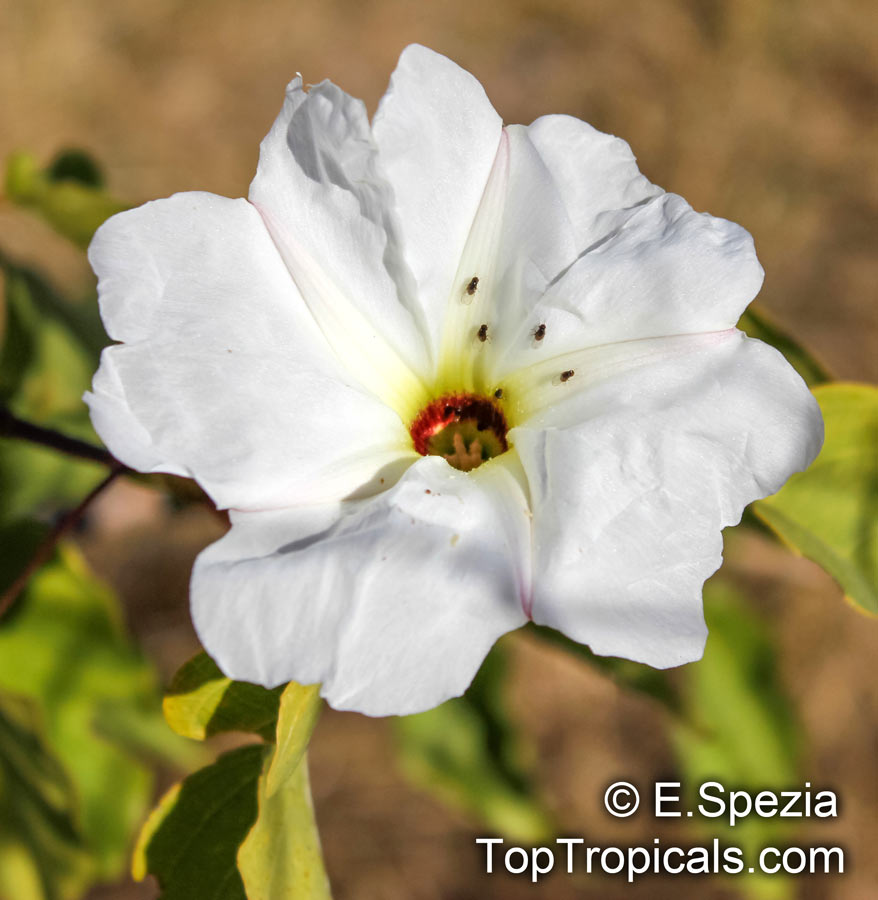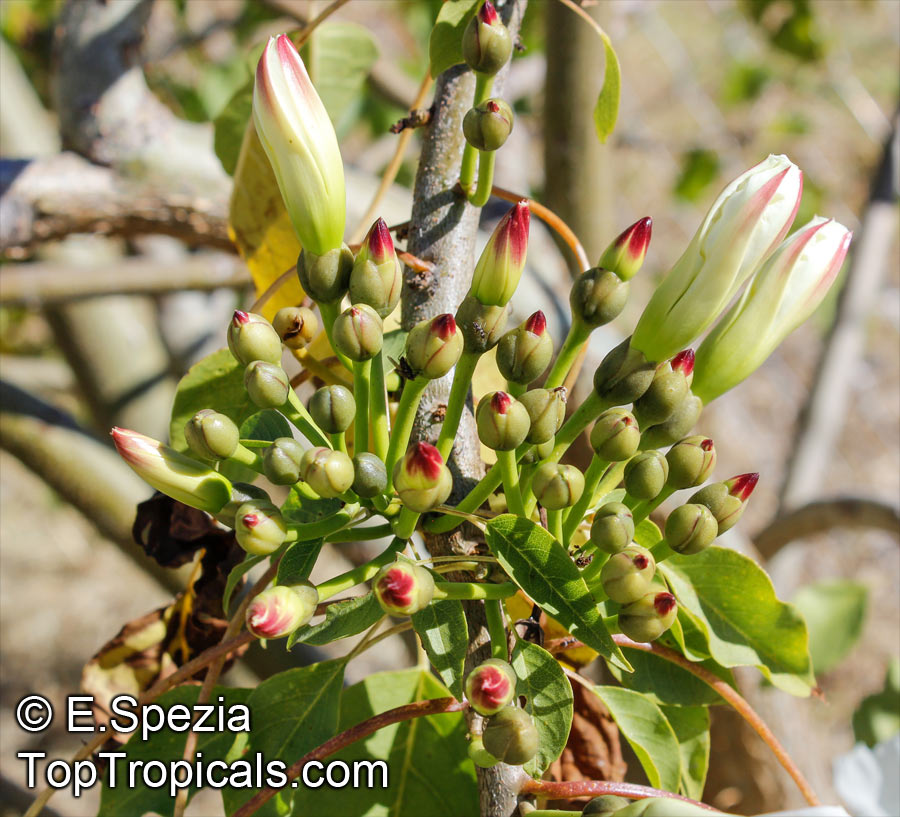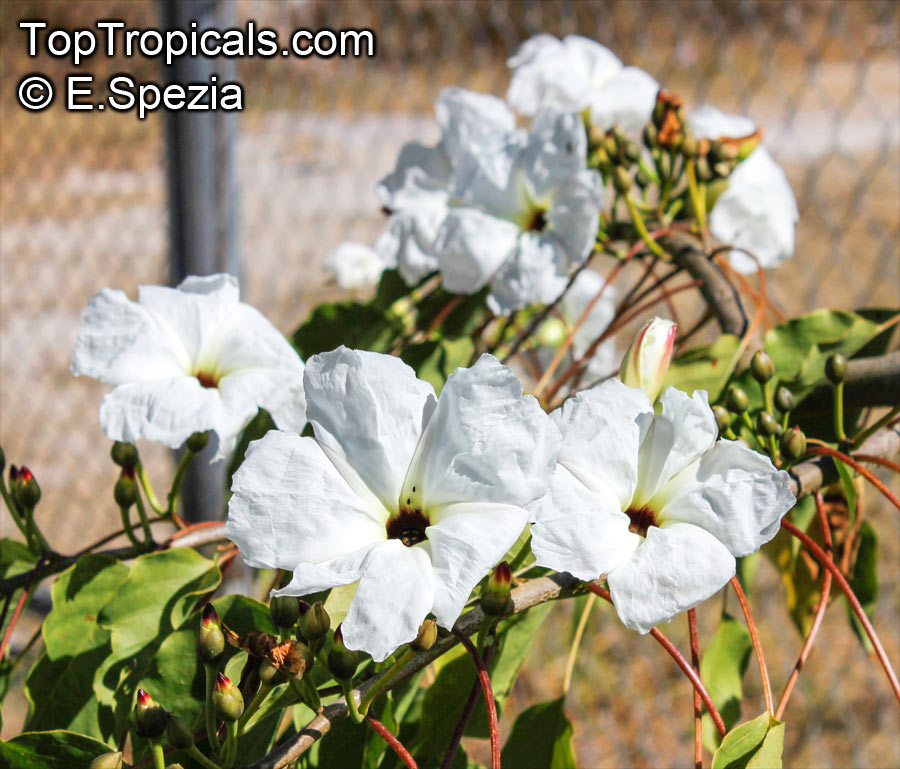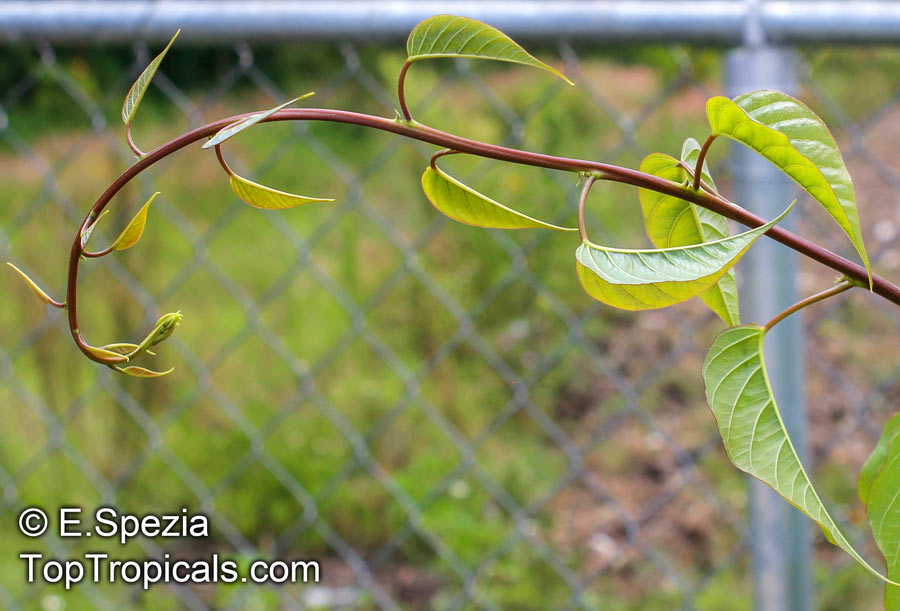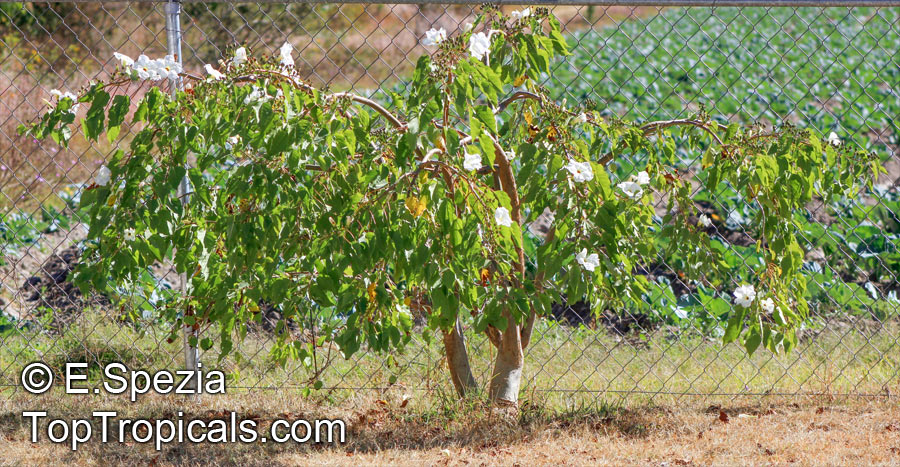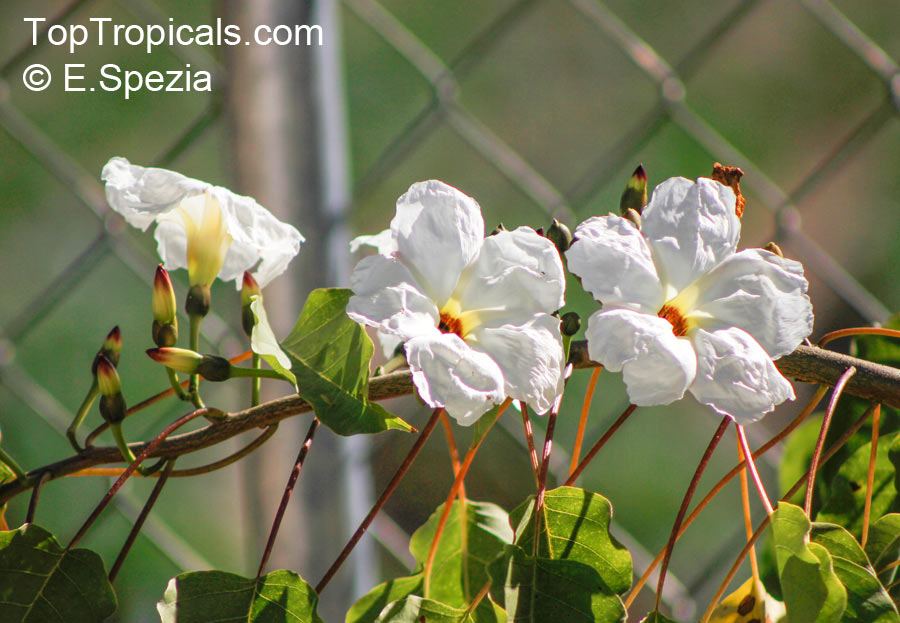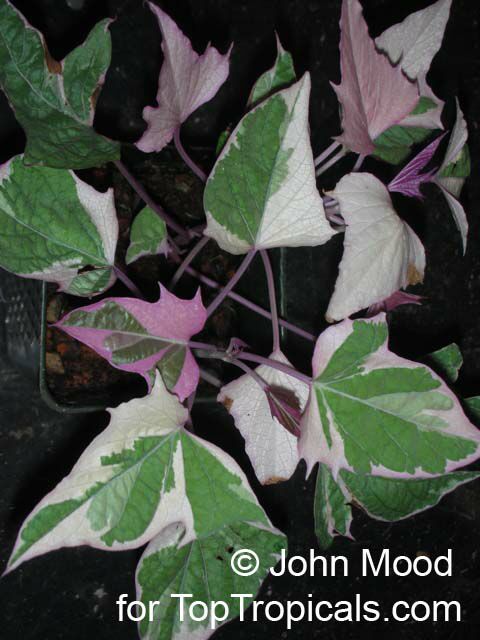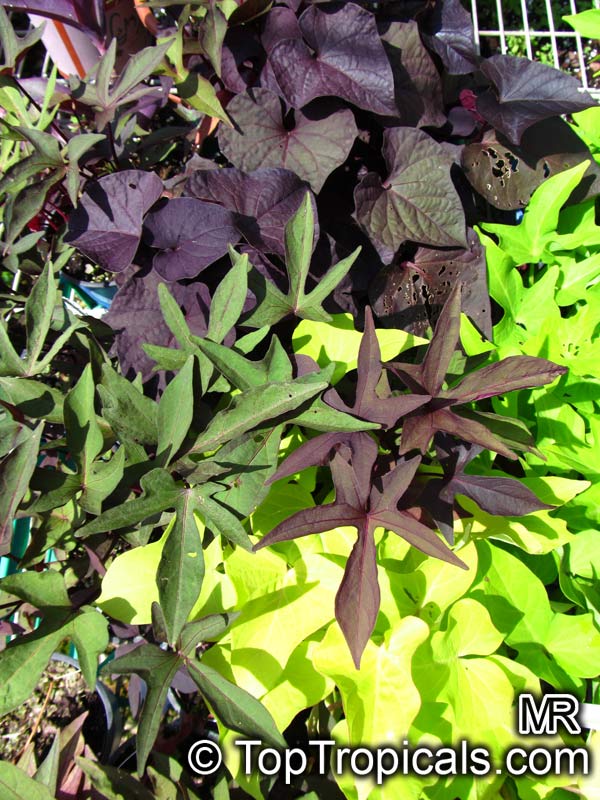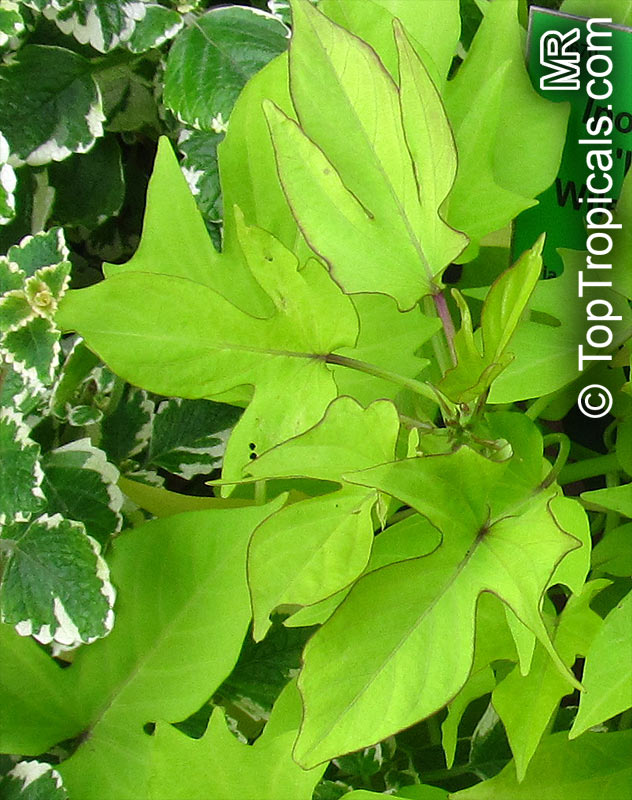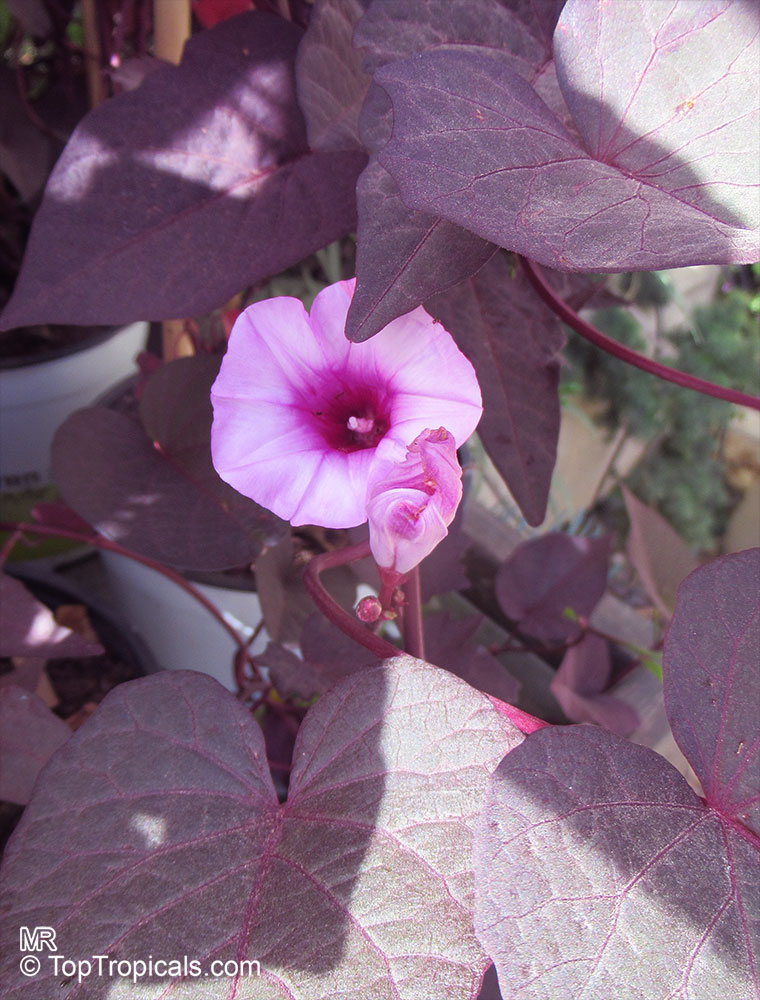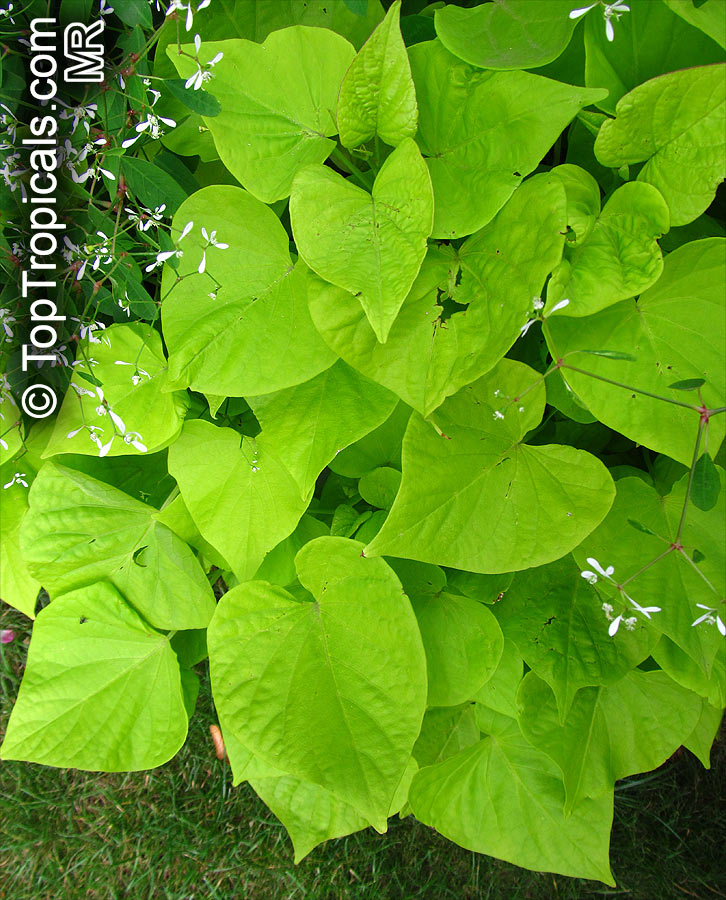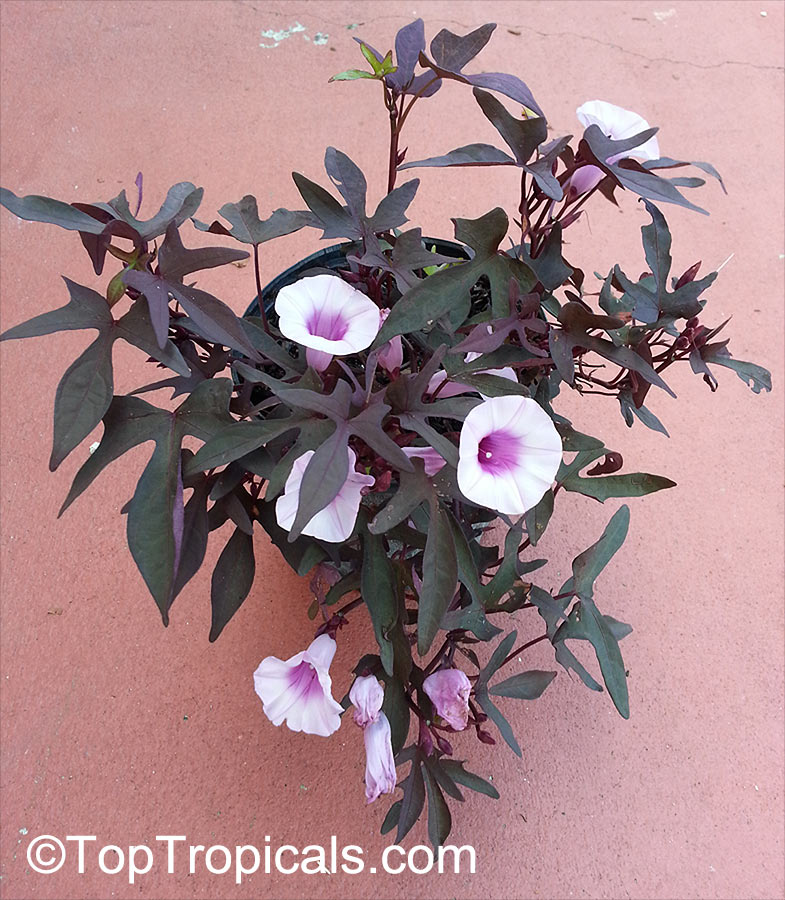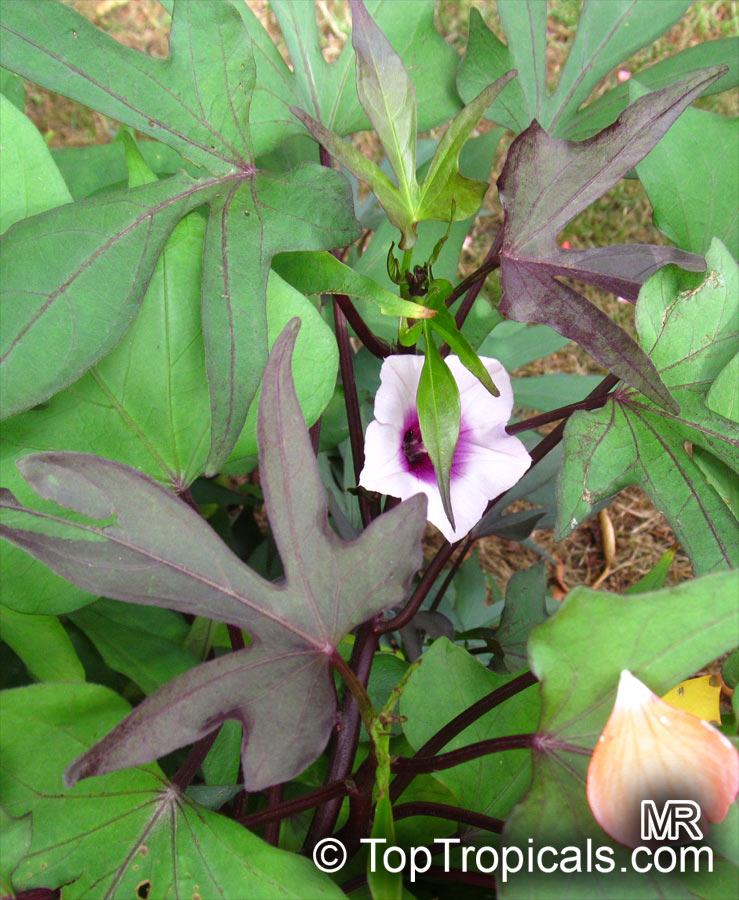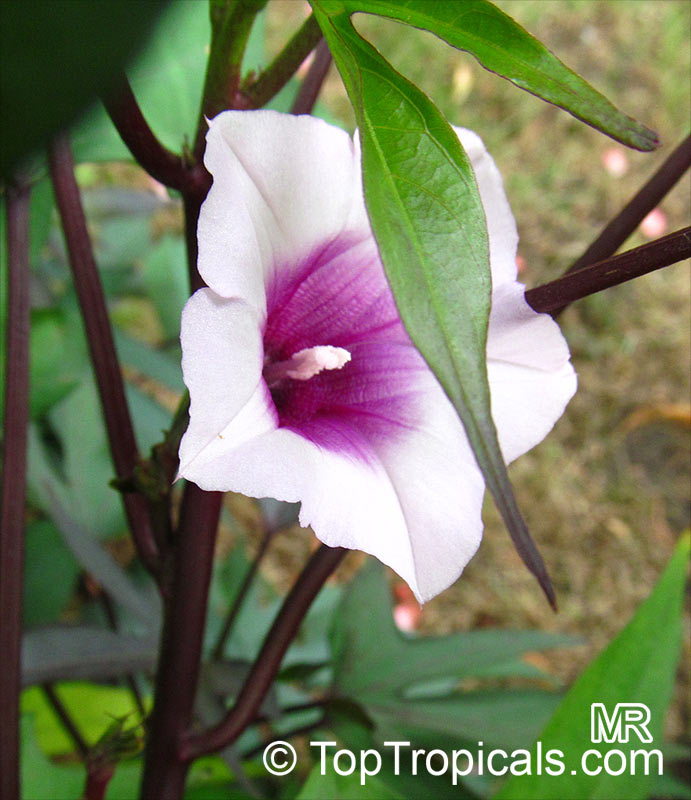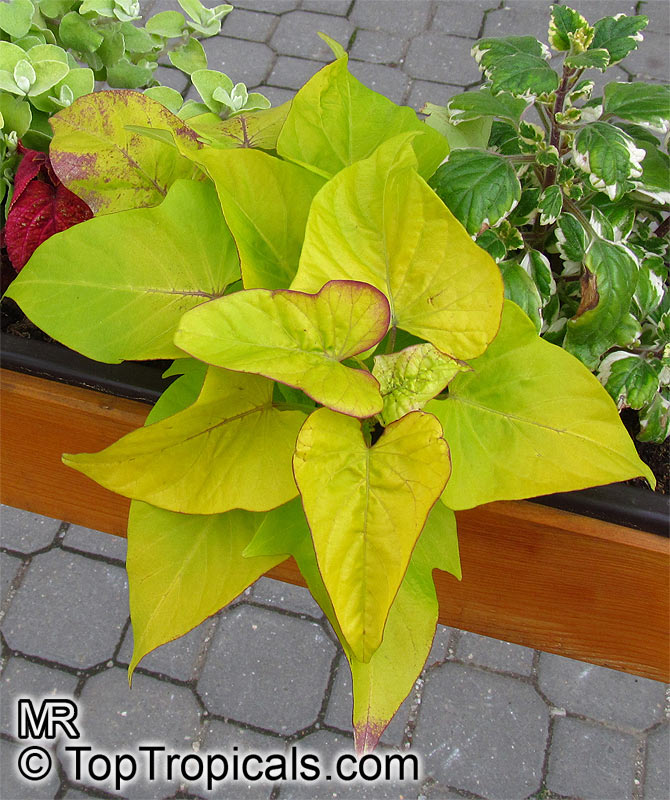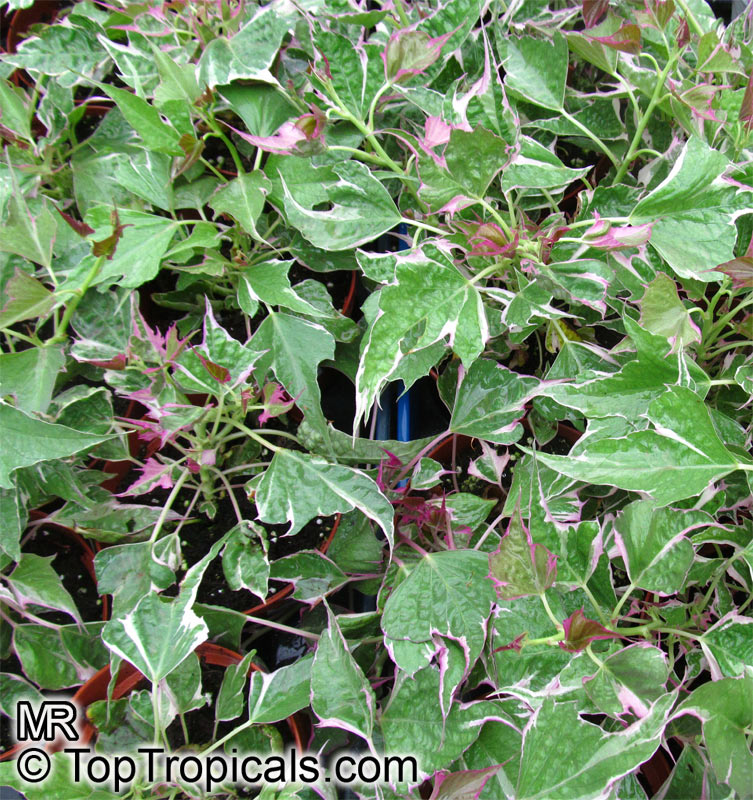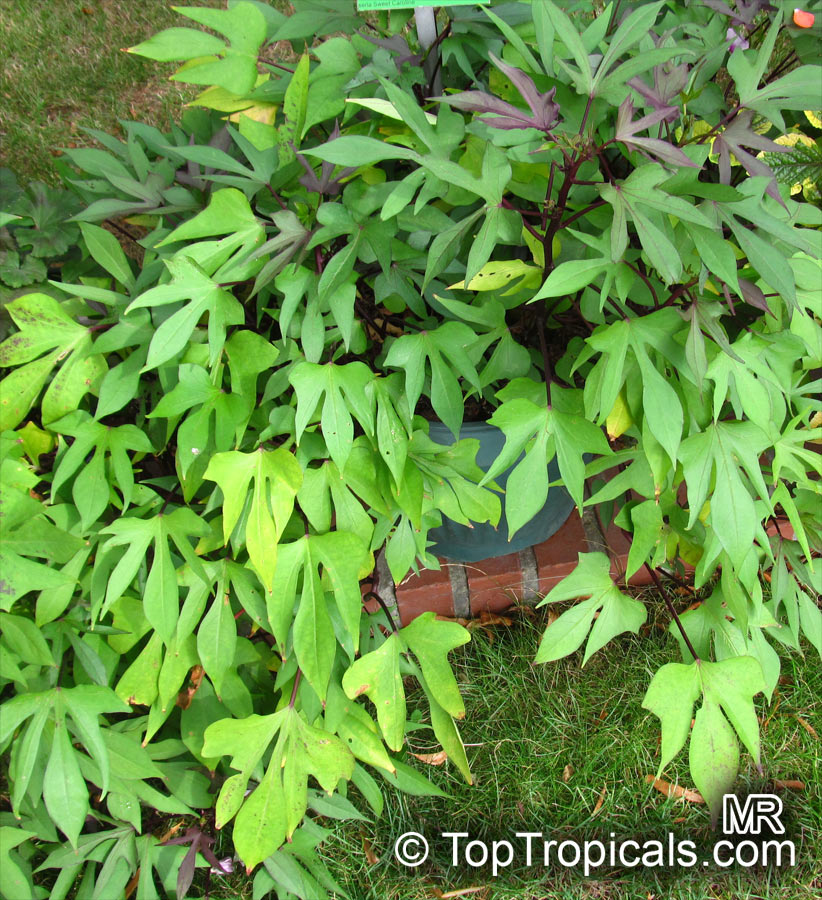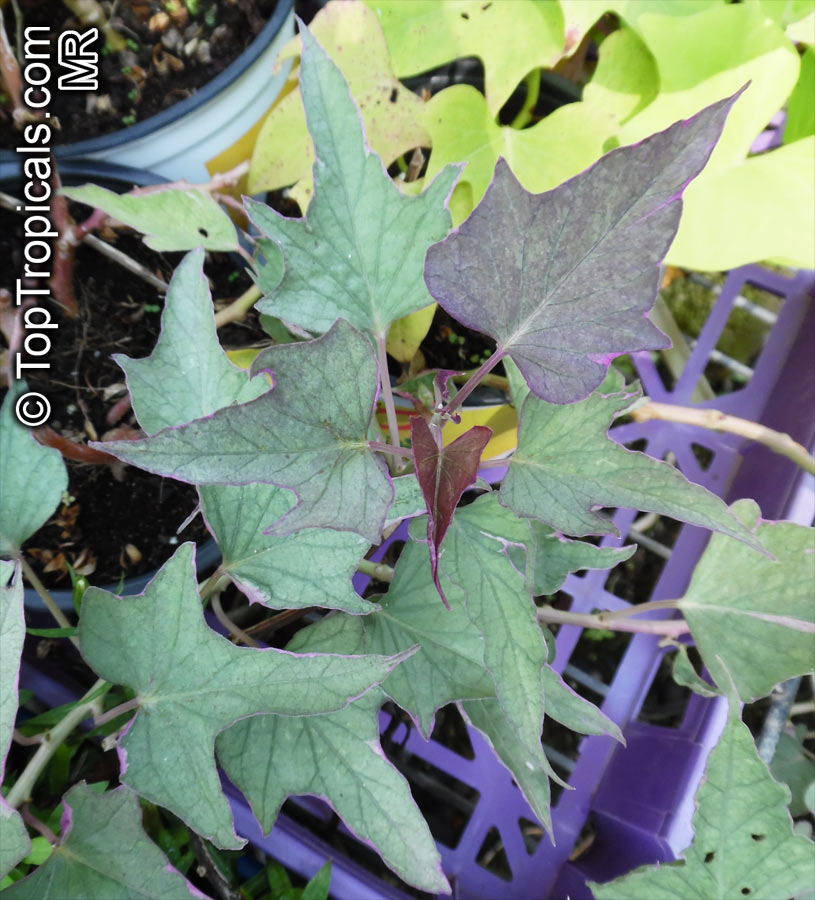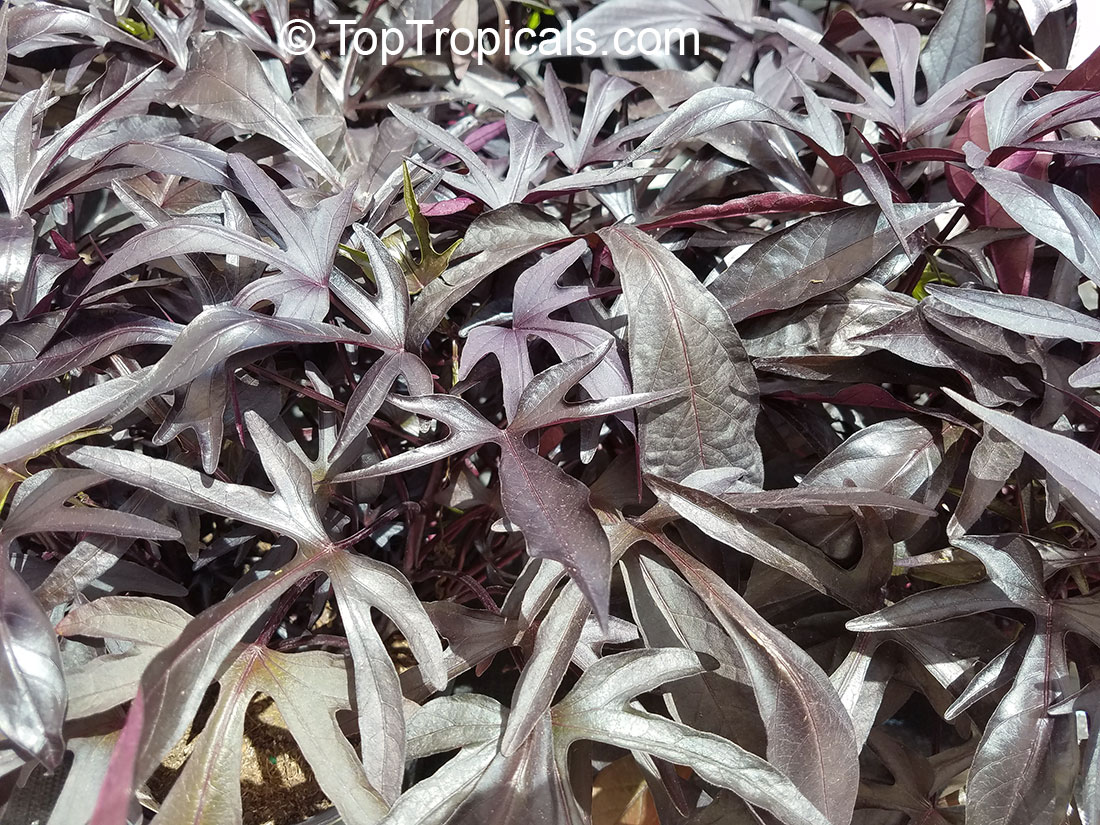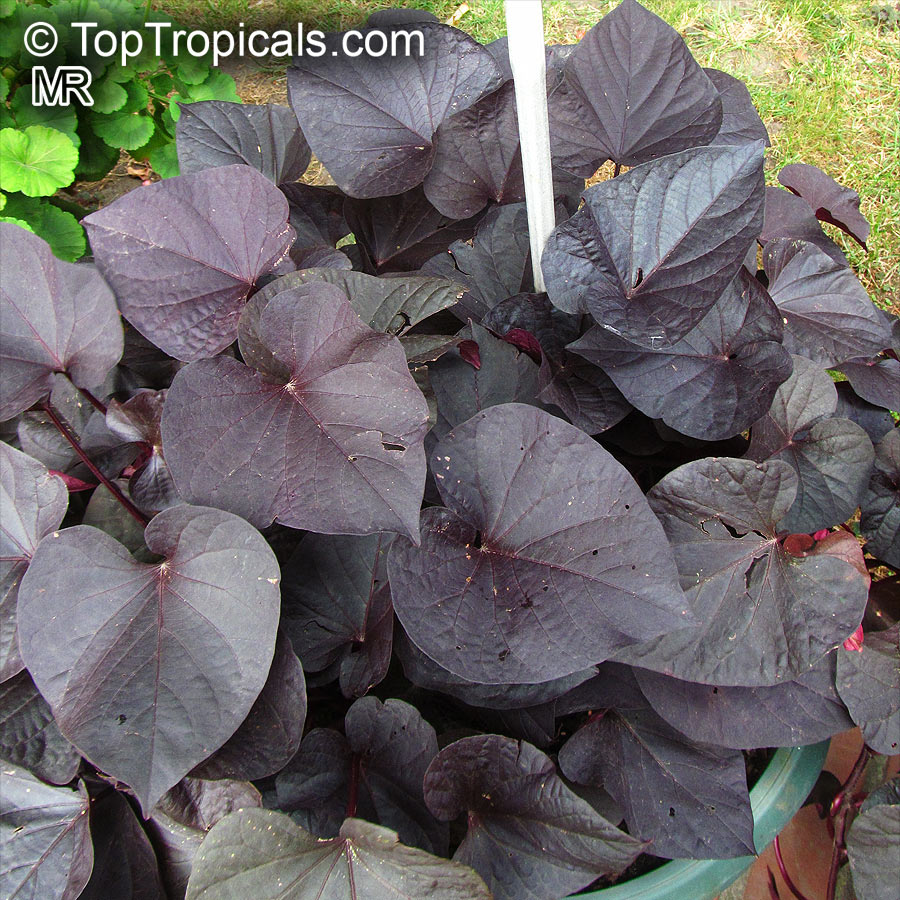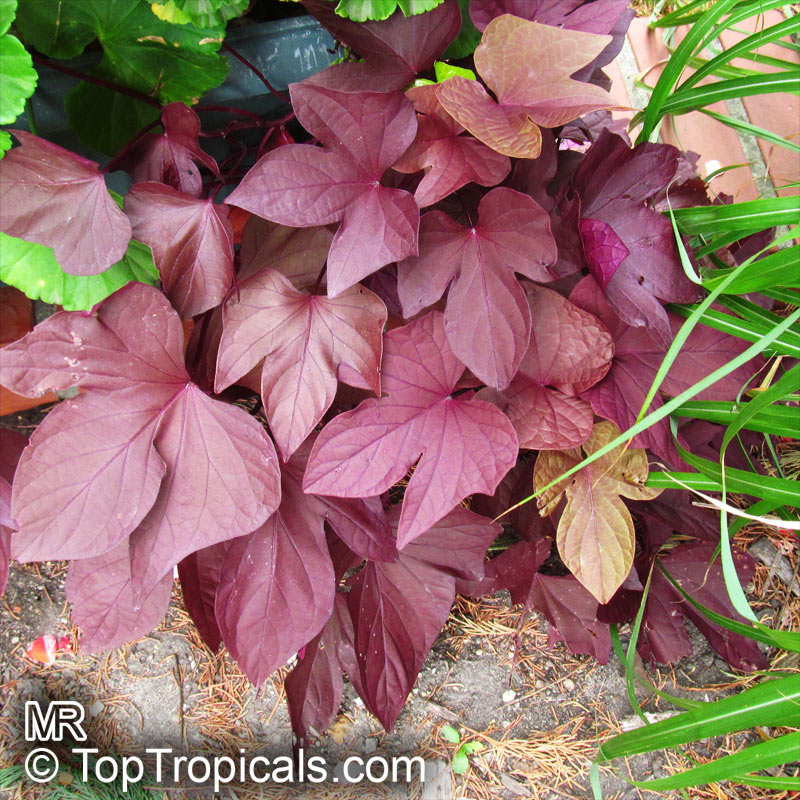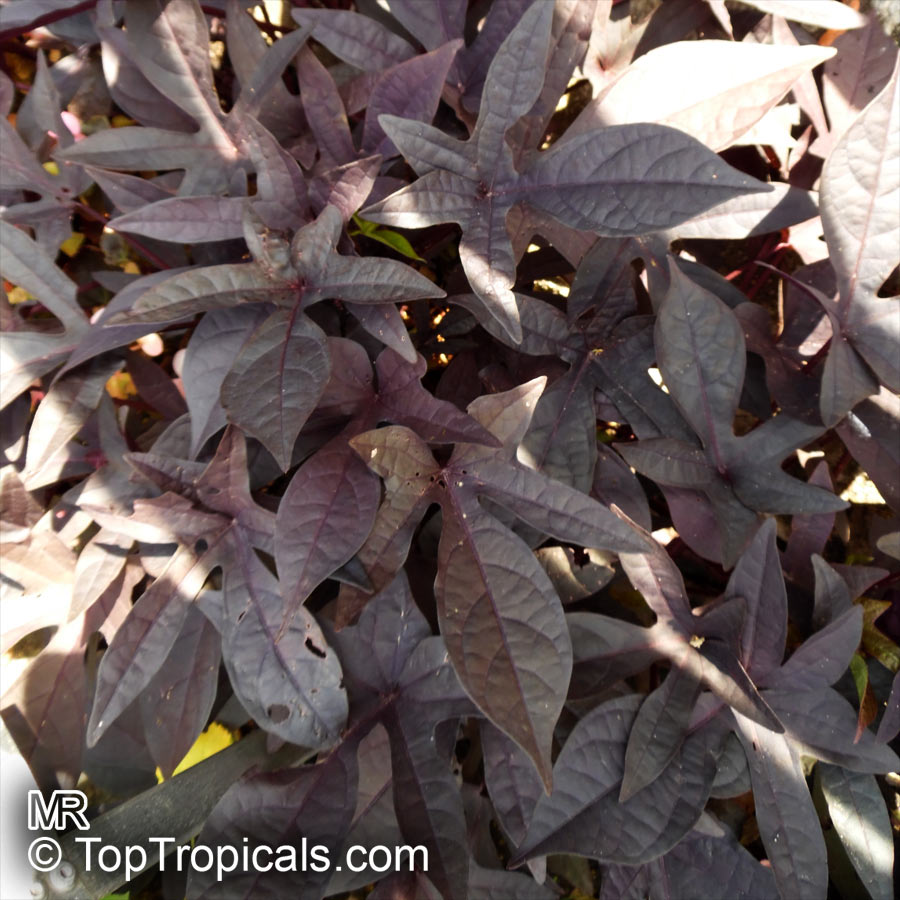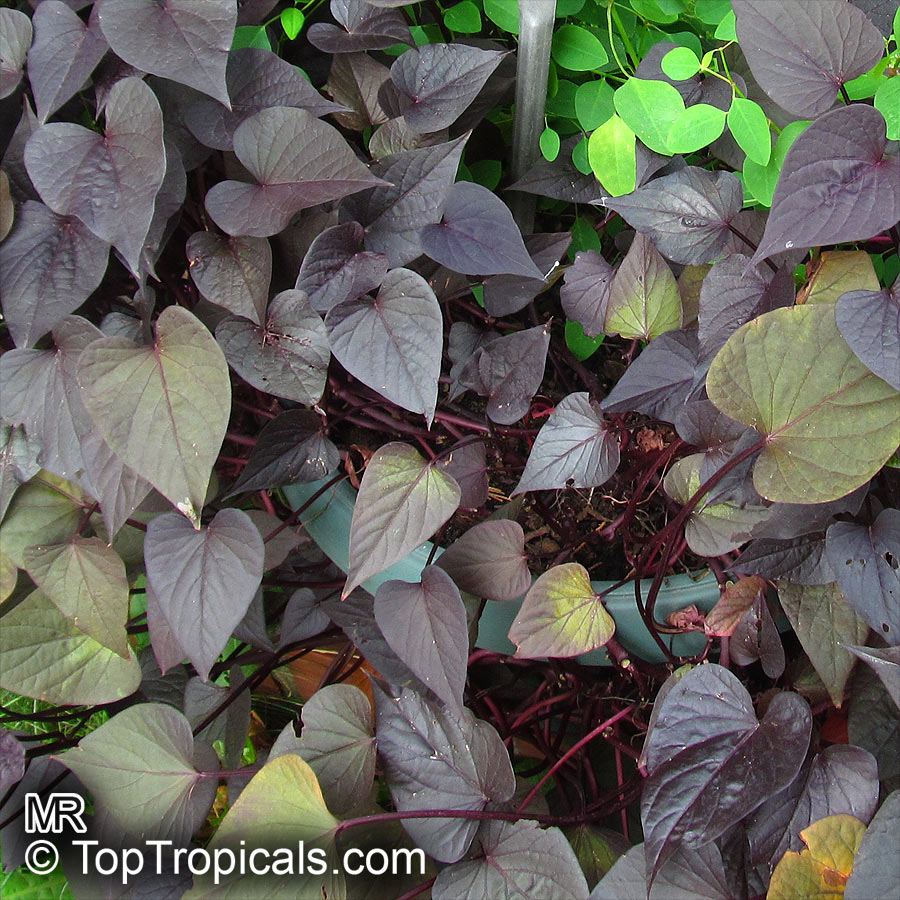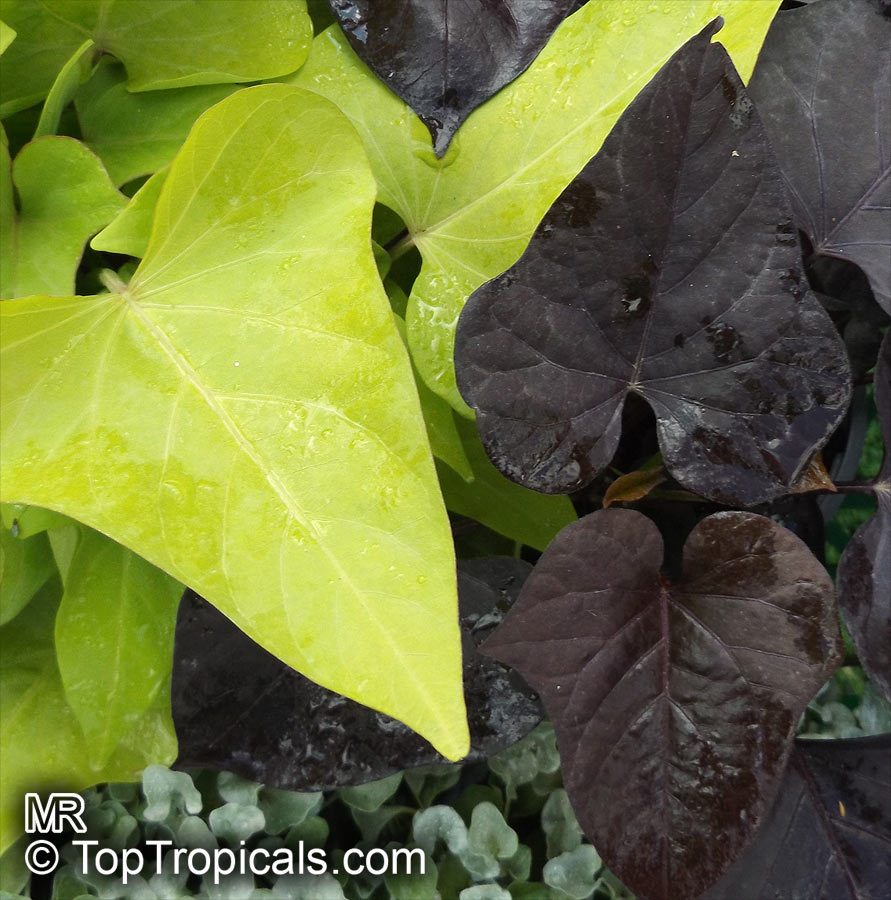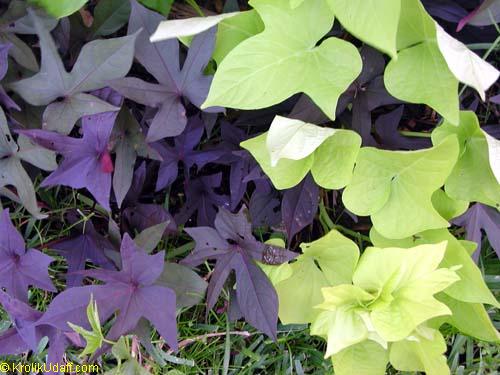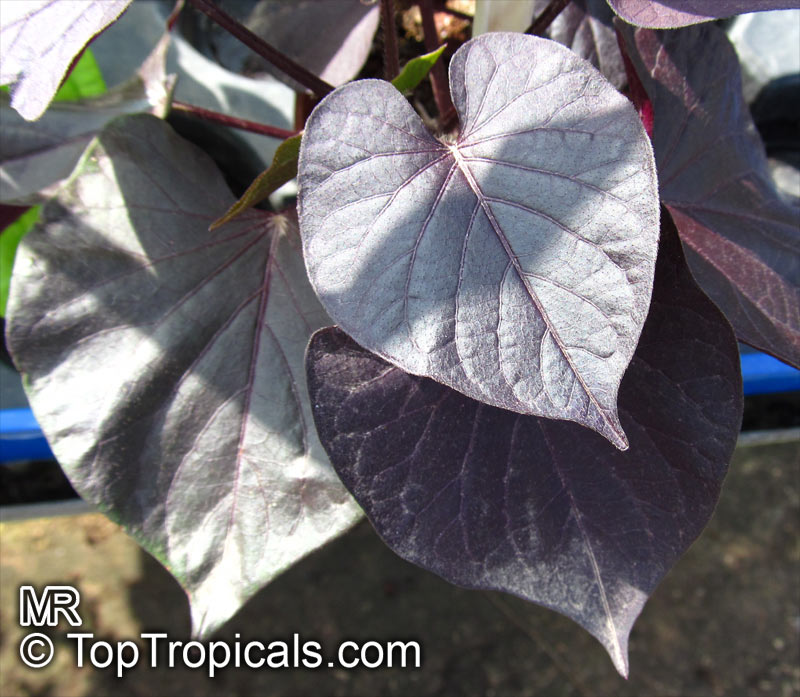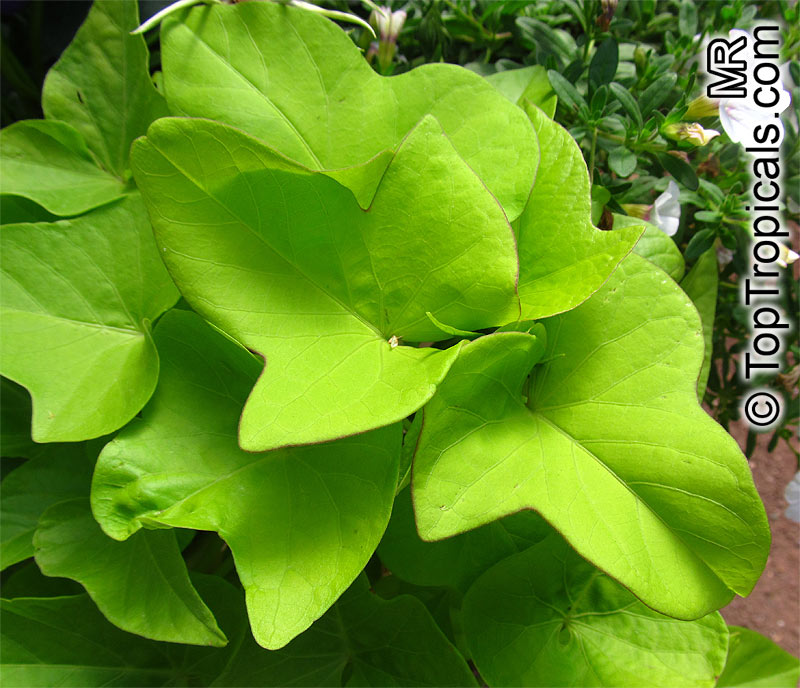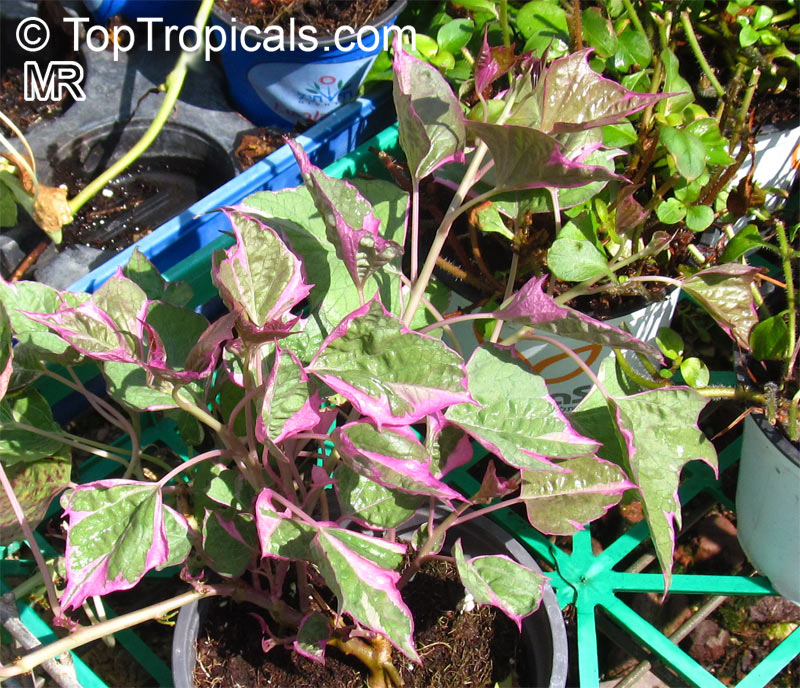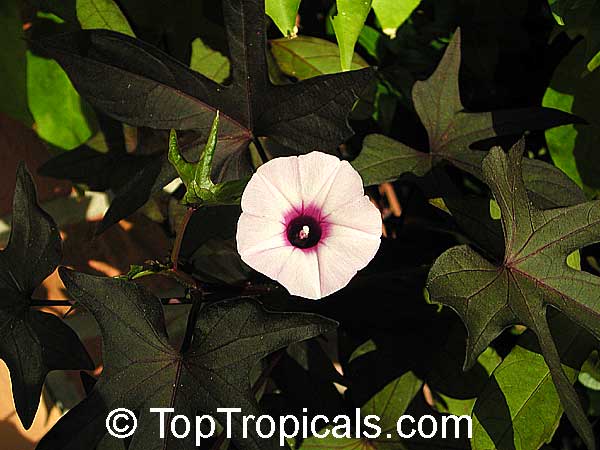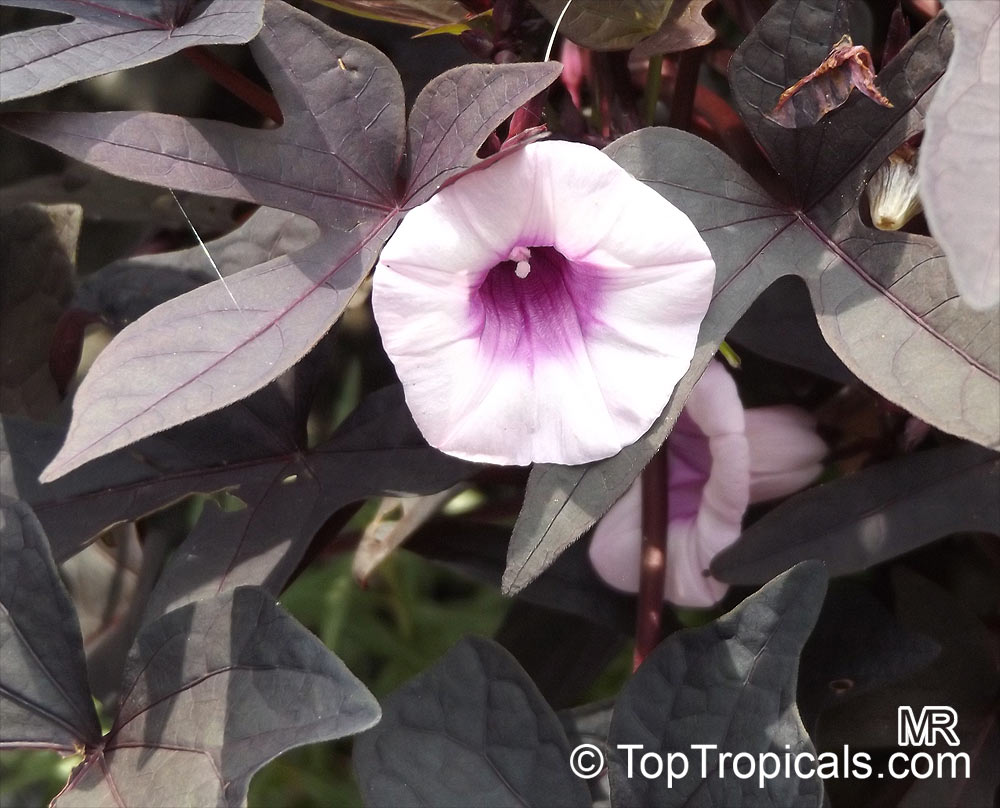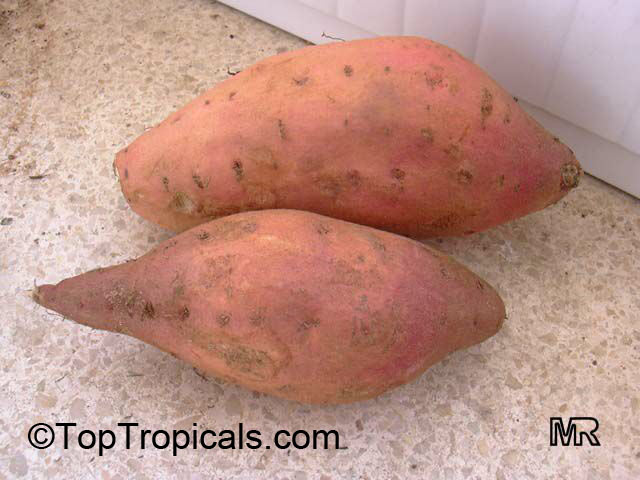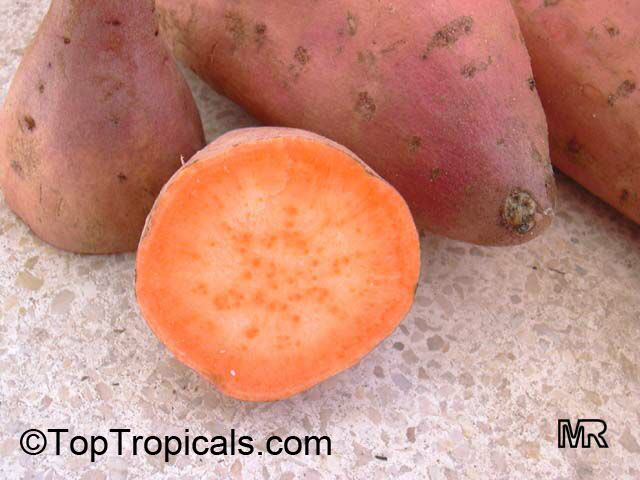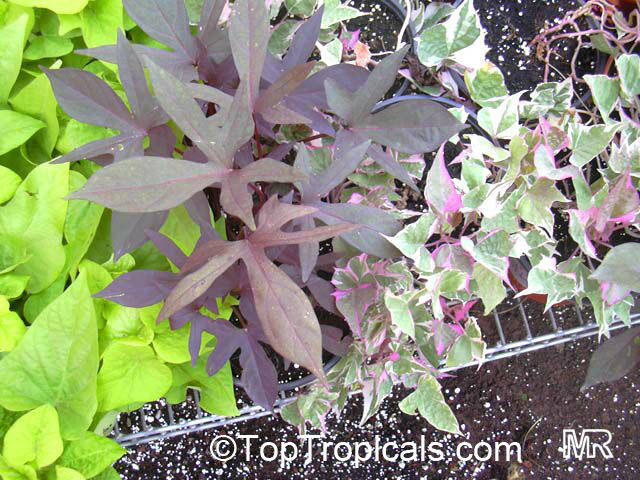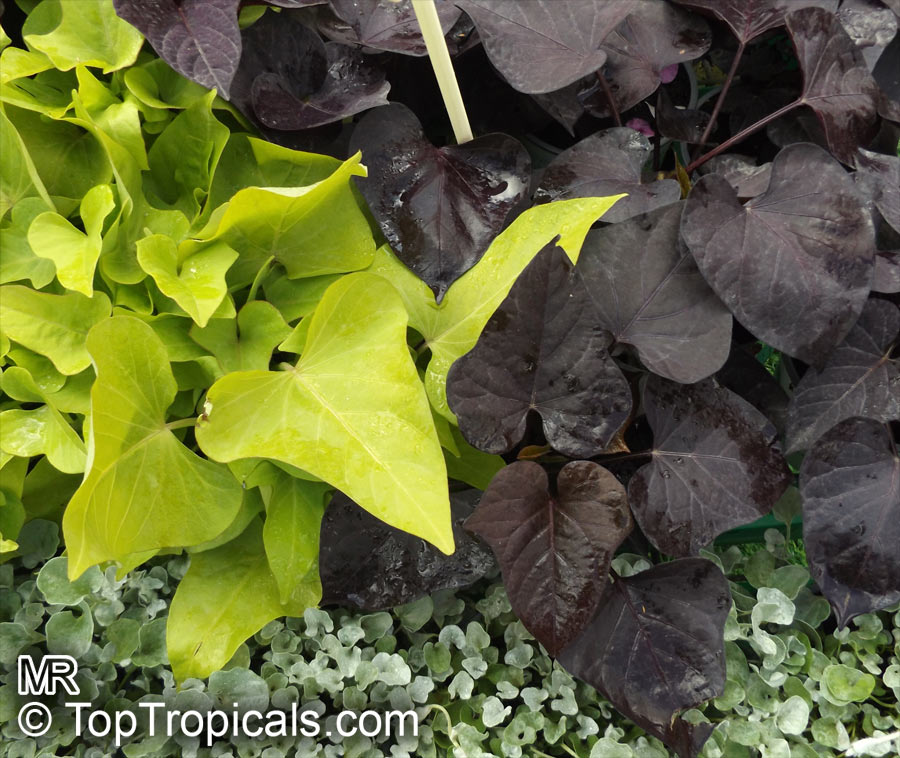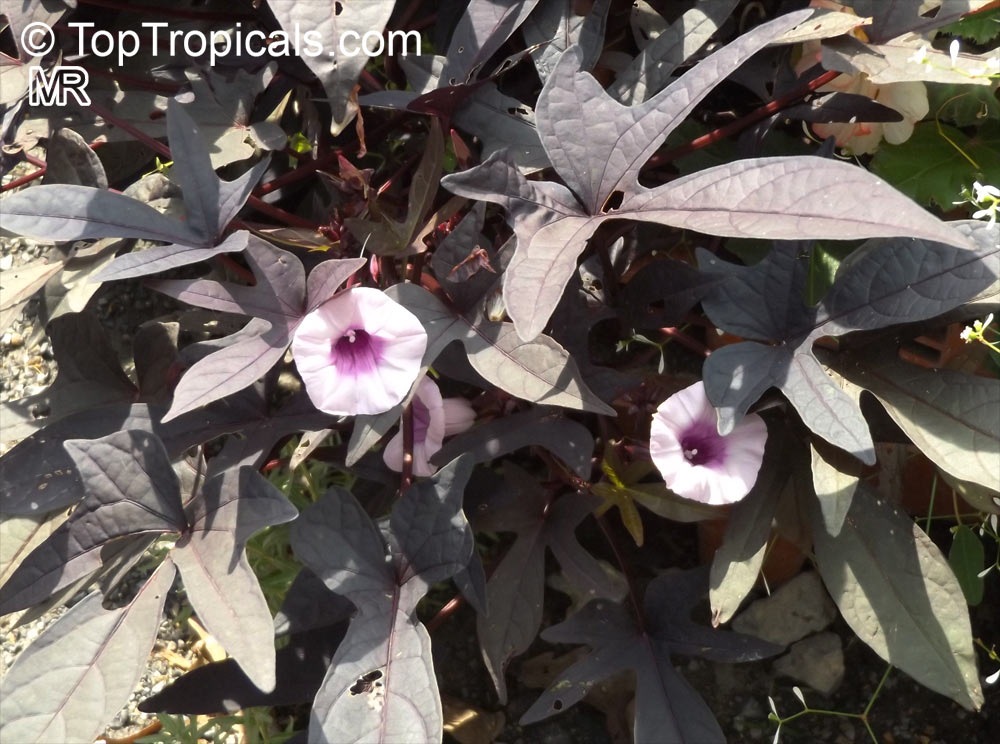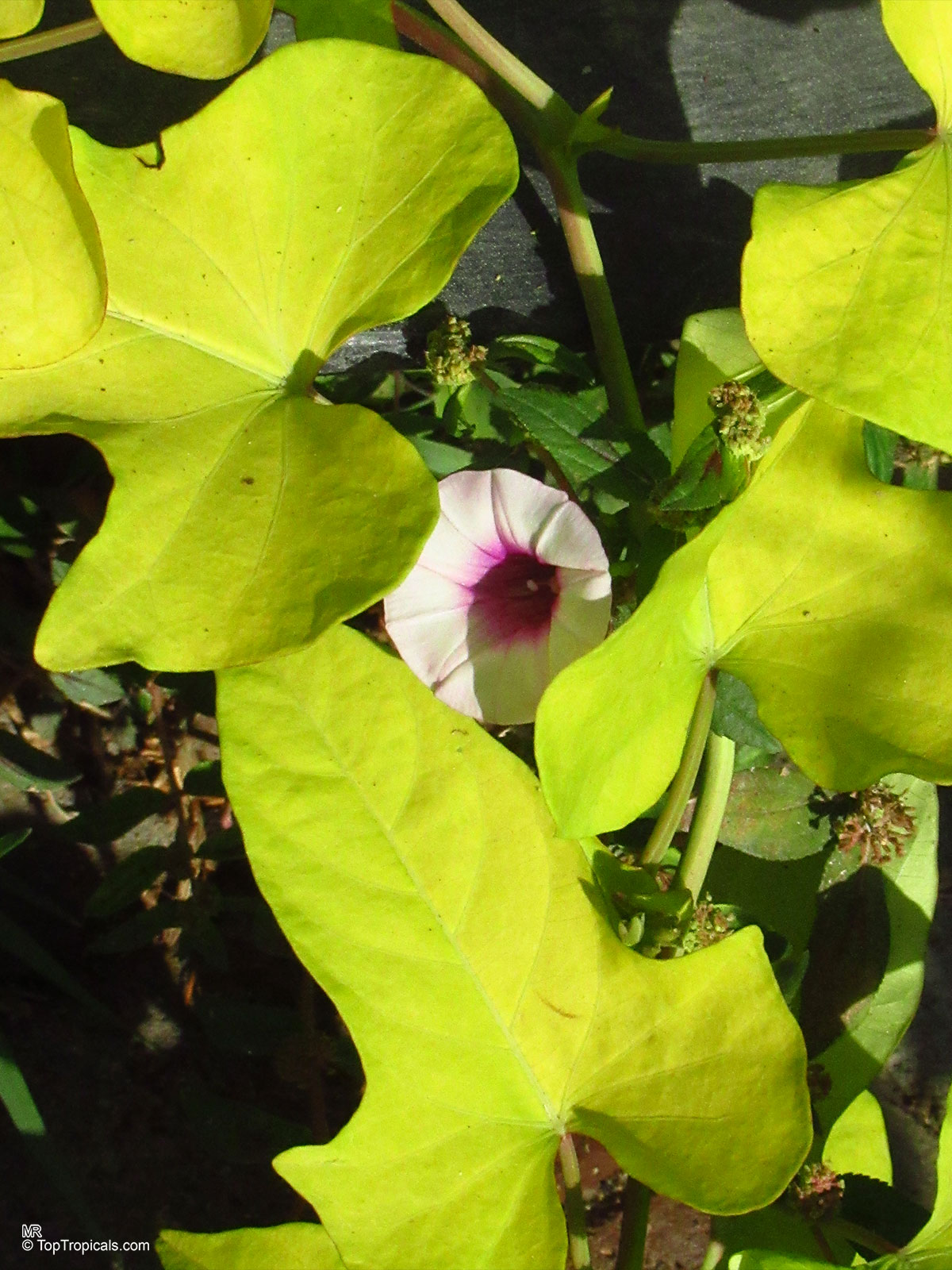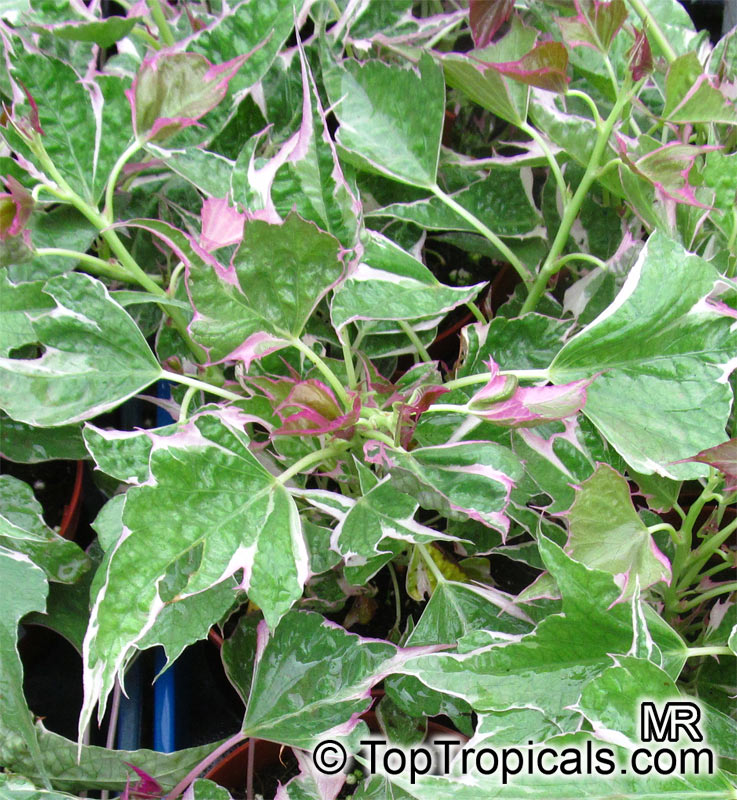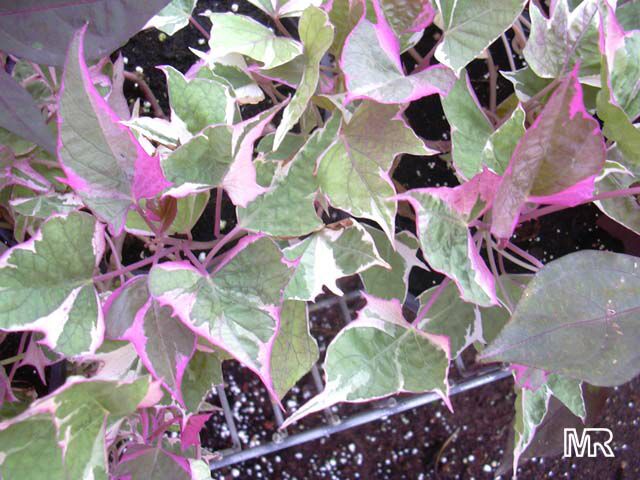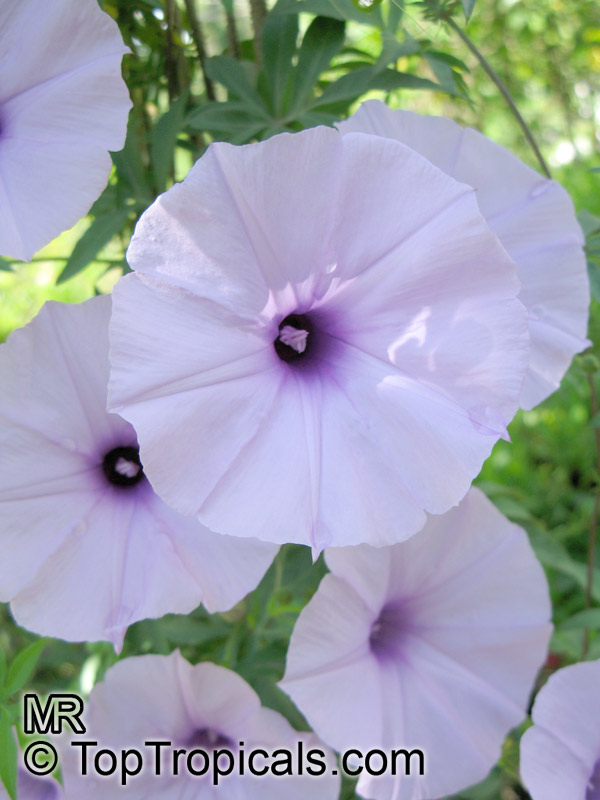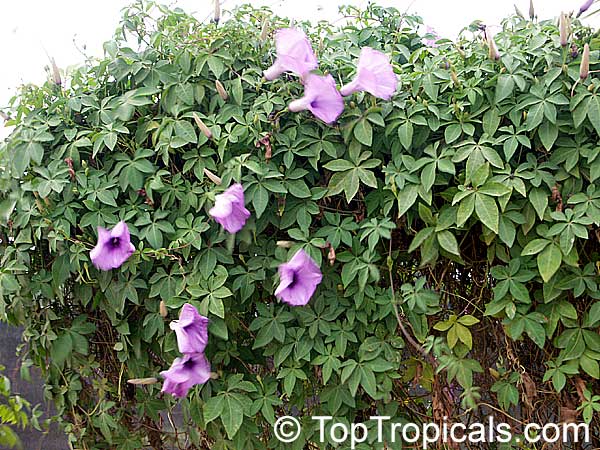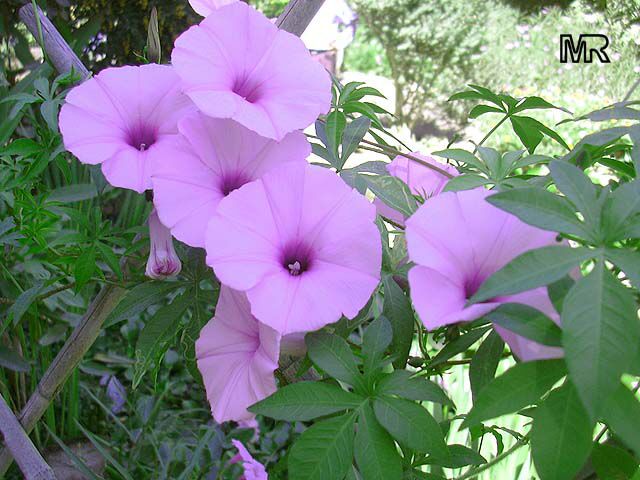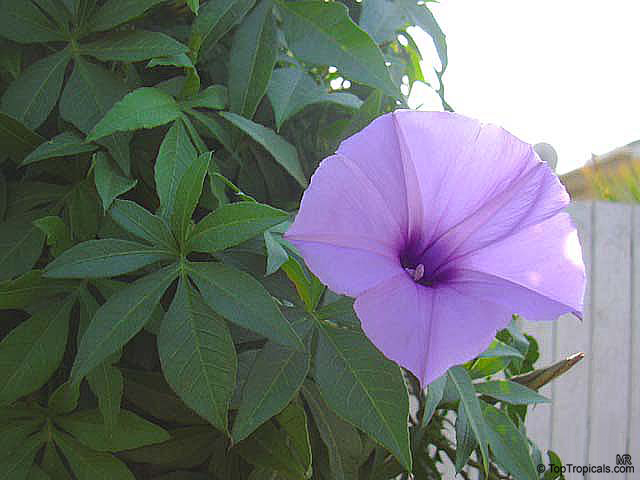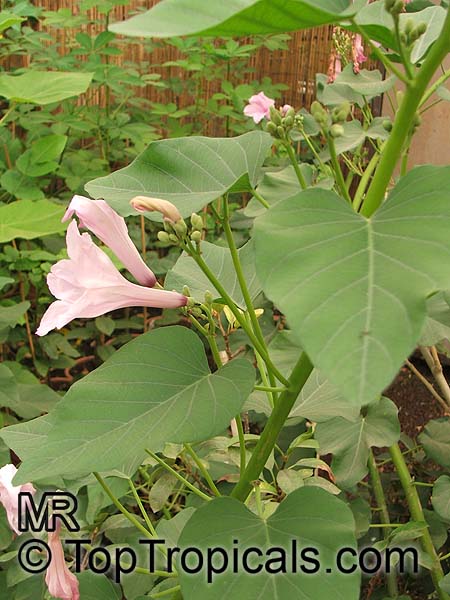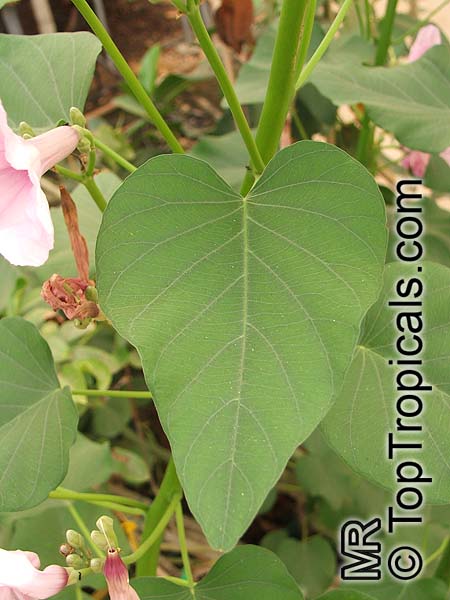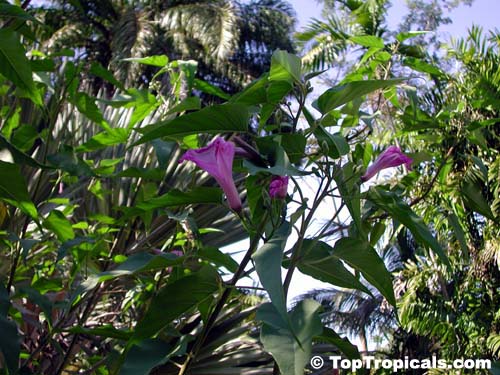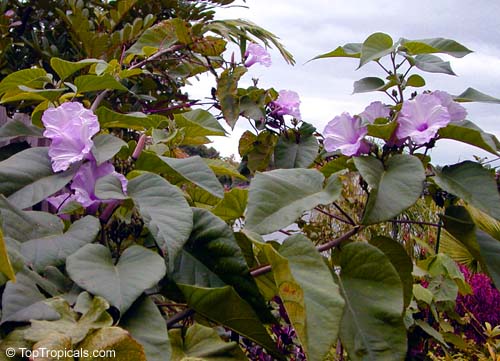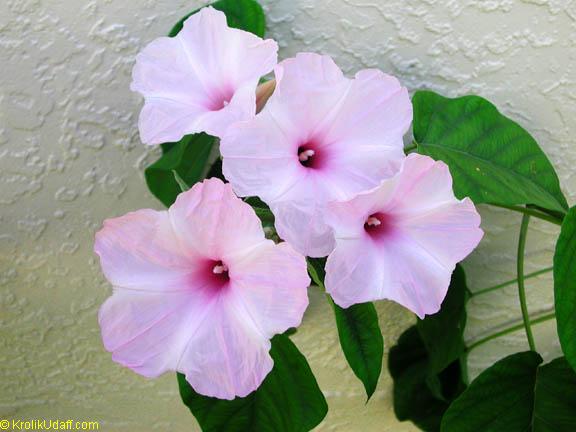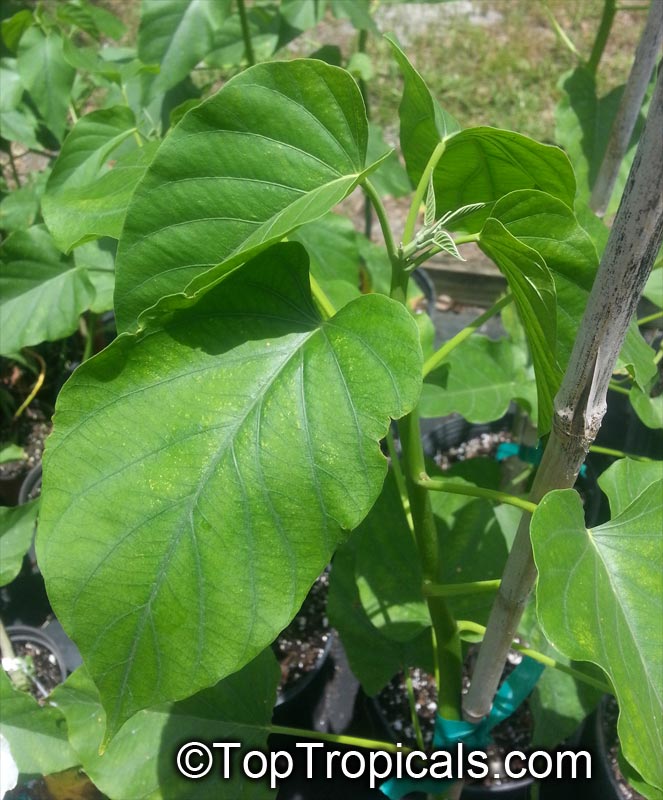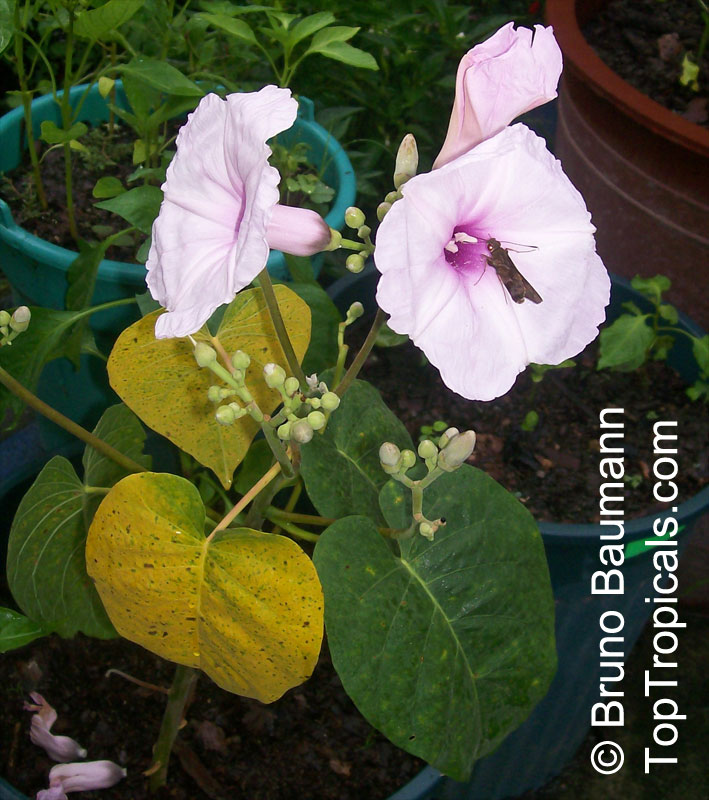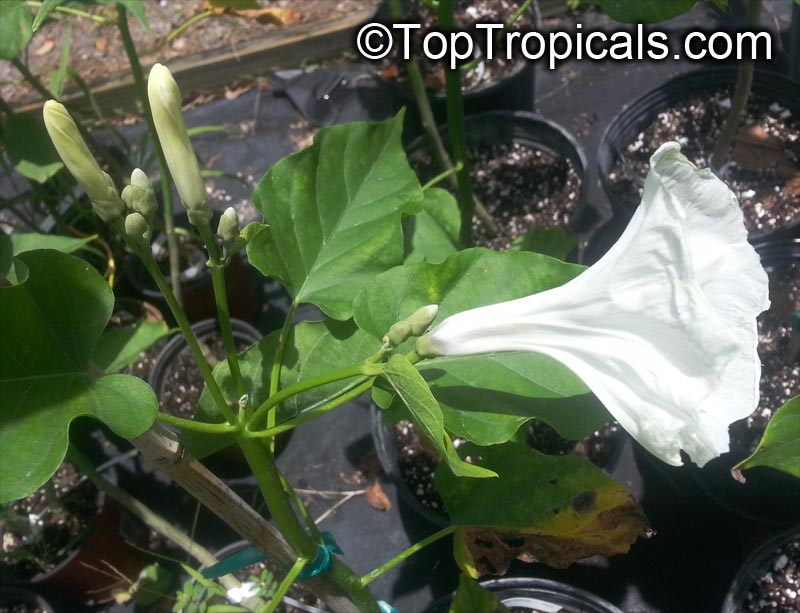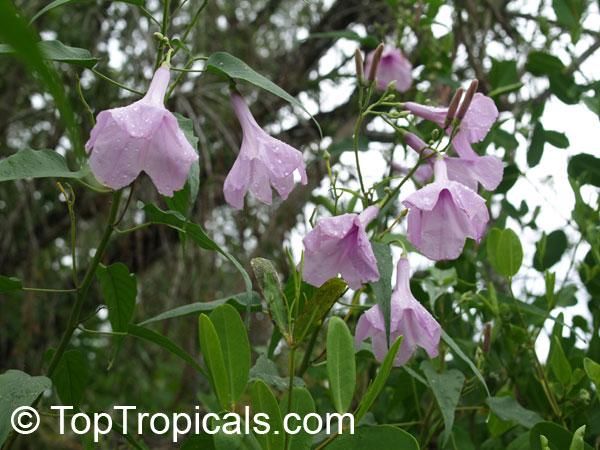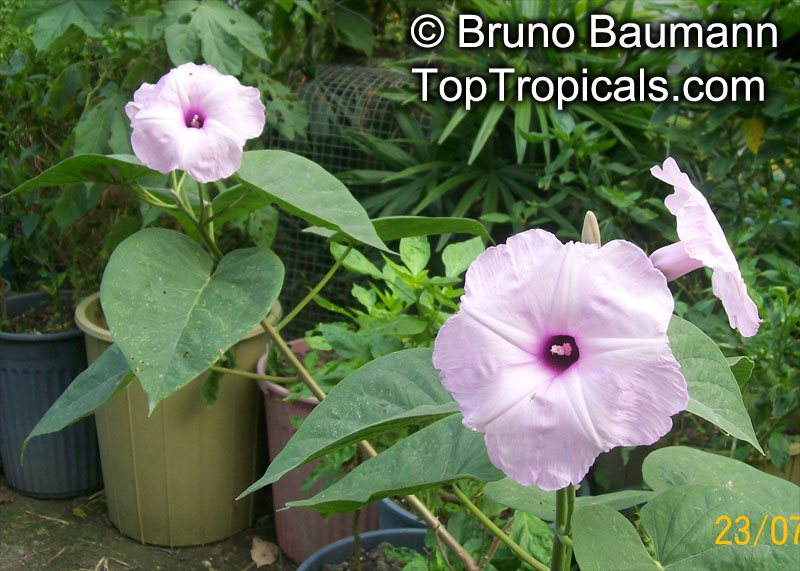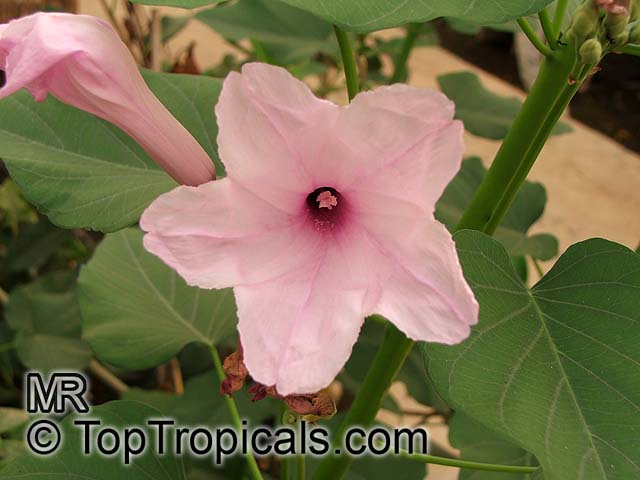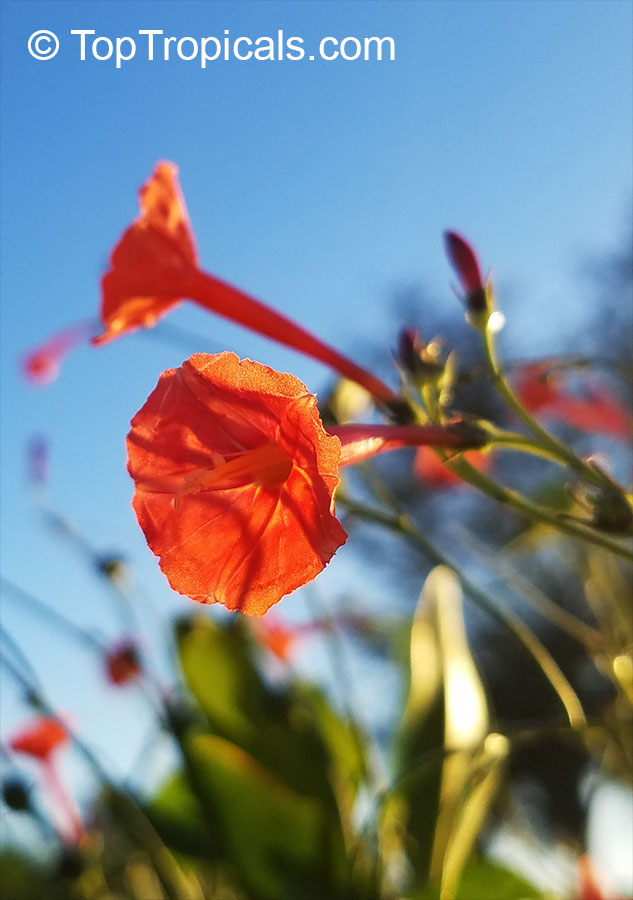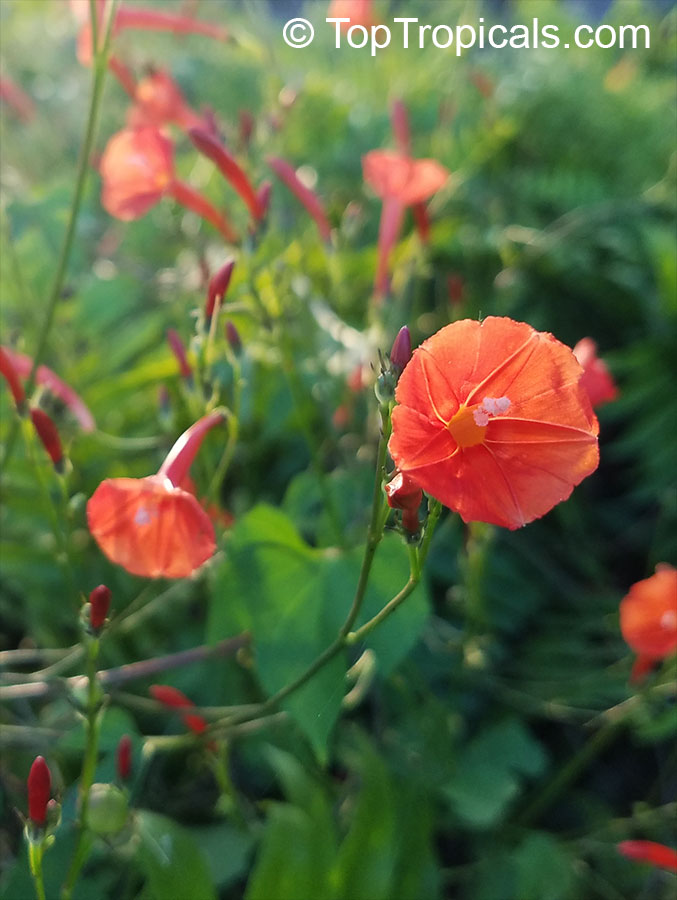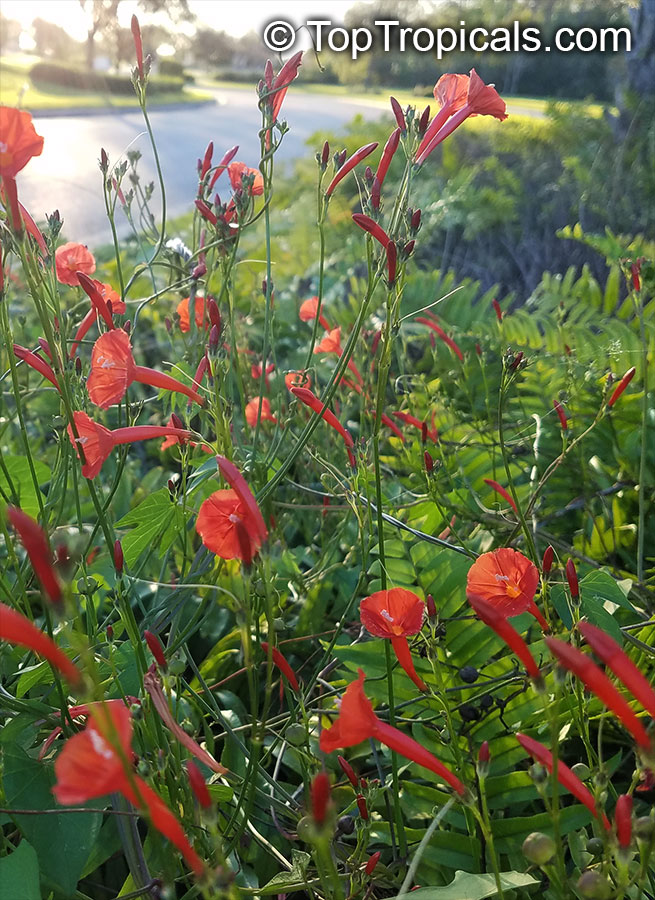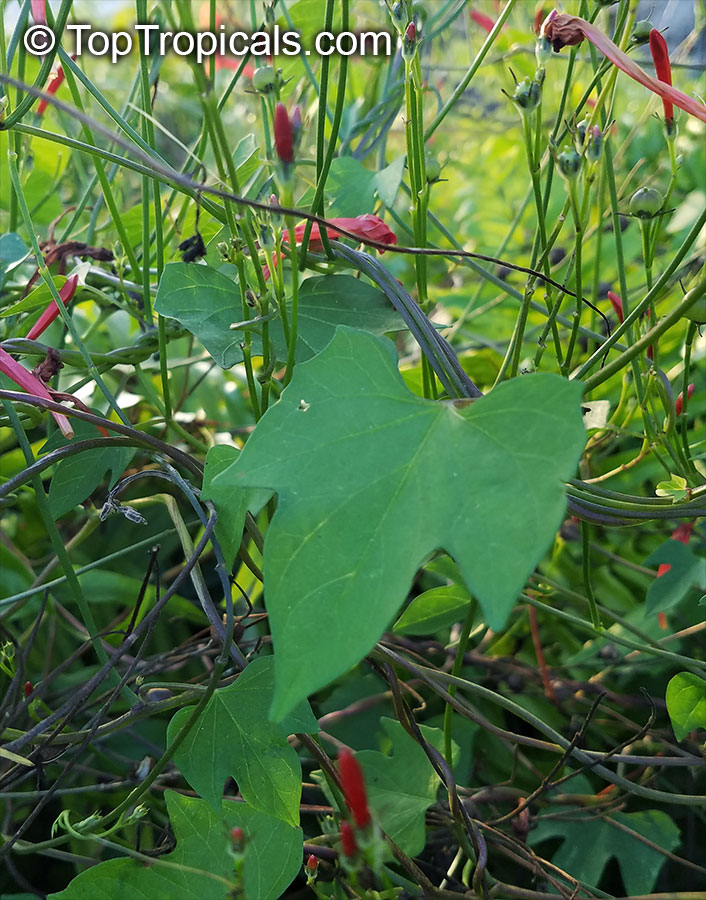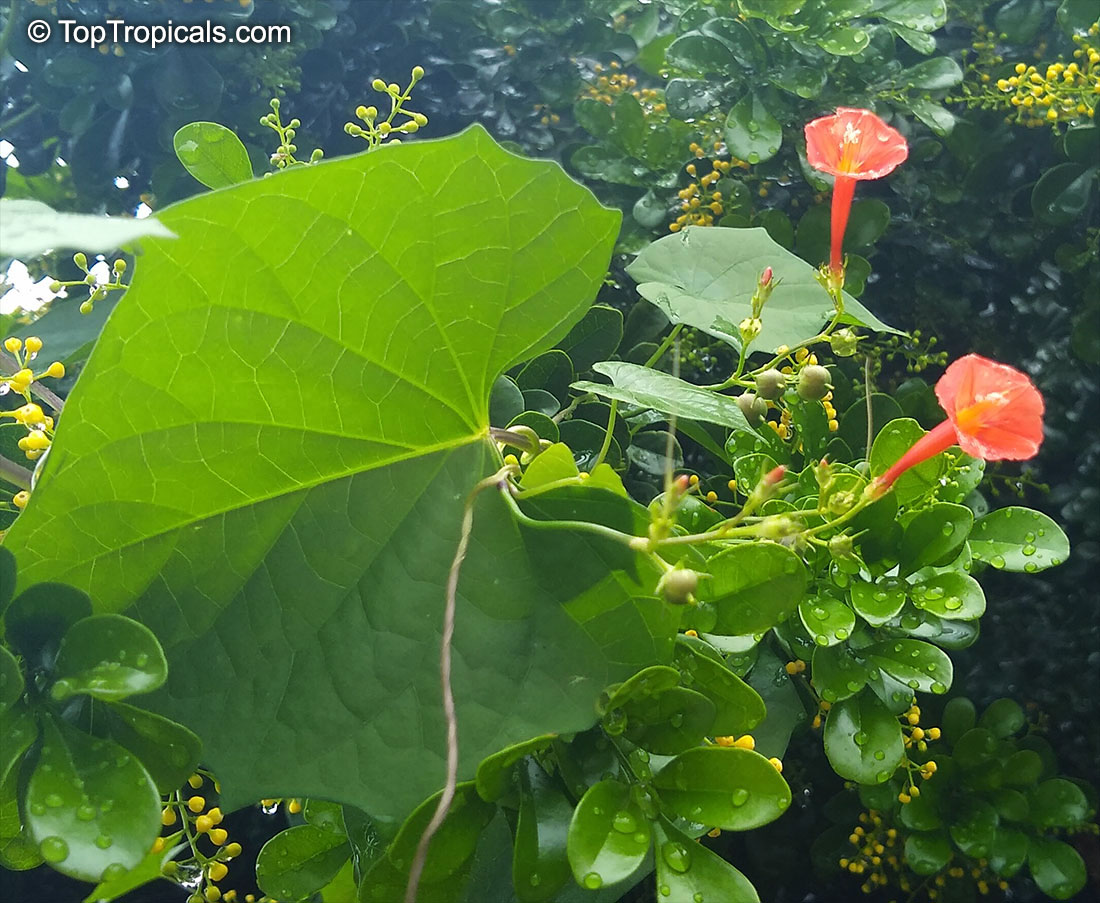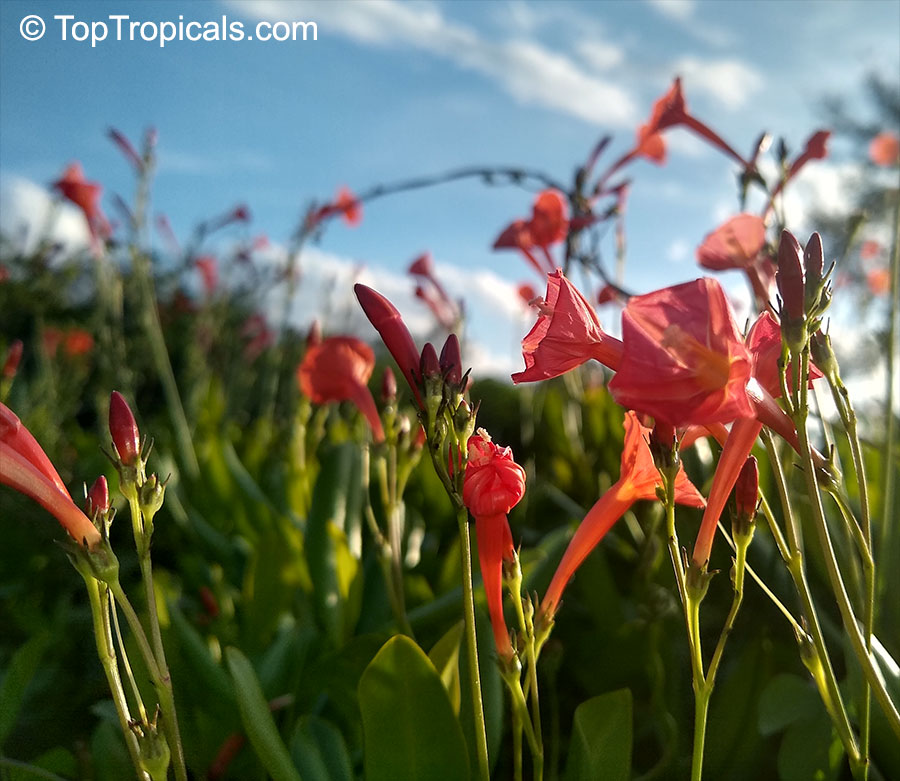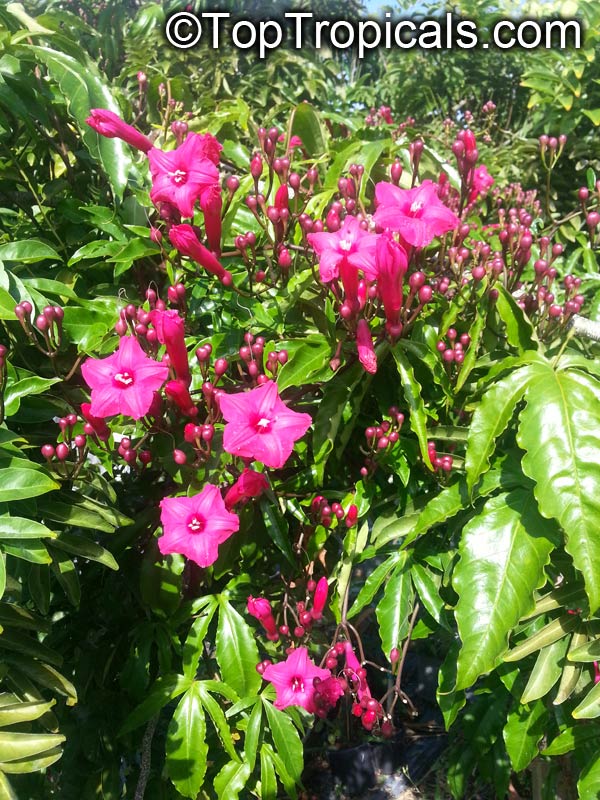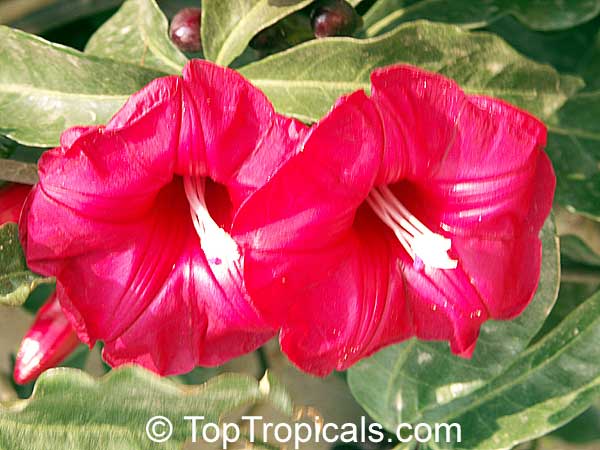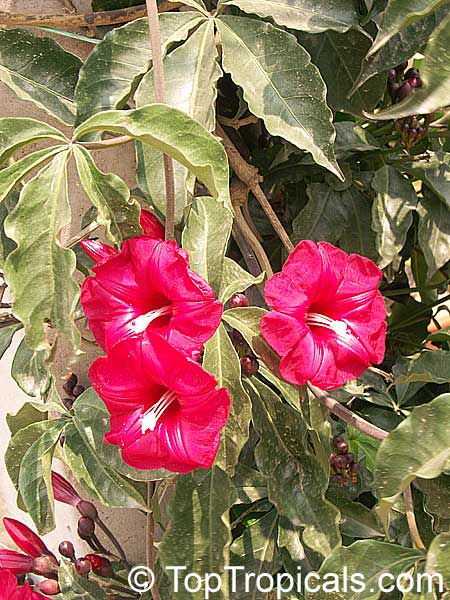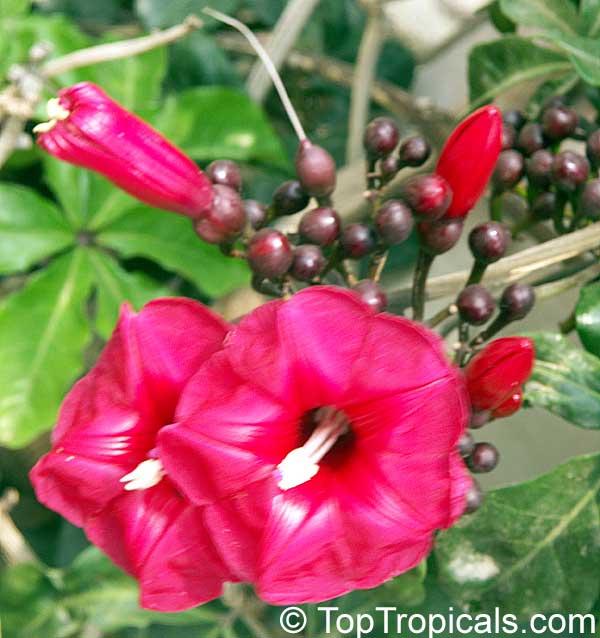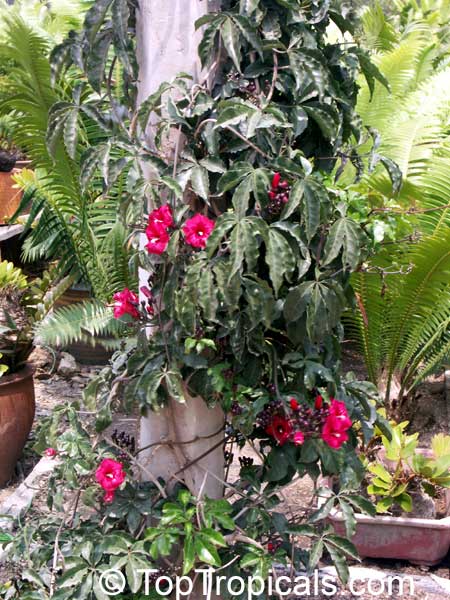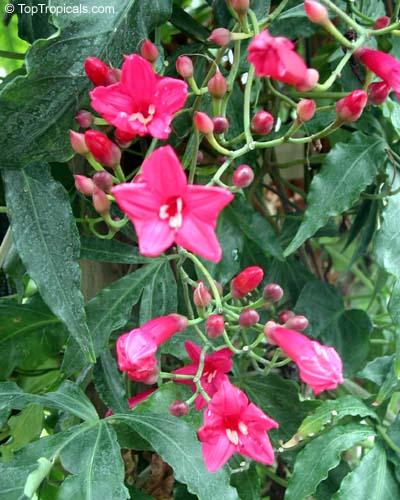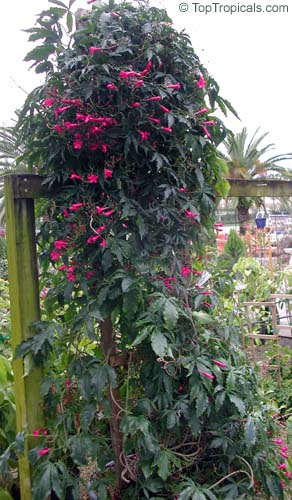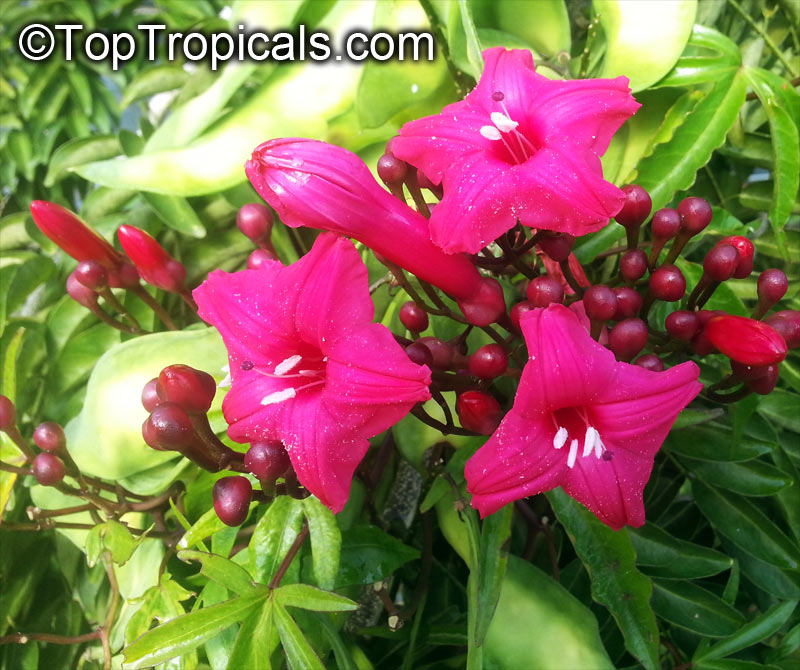Ipomoea - Plant Encyclopedia Results
Top Tropicals Plant Encyclopedia
| Number of plants found: 22 | Next | 
|
Go to page: | 1 | 2 | 3 |
Botanical names: Calonyction aculeatum, Ipomoea alba
Common name: Giant moonflower
Family: Convolvulaceae
Origin: Tropical America









When grown in their native climates, moonflowers (Calonyction aculeatum) prefer a full sun to semi-shade position and need regular water. In cooler regions, the vine should be grown in a container and placed in a warm, sheltered area of the garden. It needs to be watered regularly with moderate amount of water throughout its growing season. In winter, reduce watering and move the pot to a frost-free area.
Its trumpet-shaped, white or off-white flowers bloom in the evening and are very fragrant, thus it attracts various butterflies and hummingbirds. Be aware that this flower is considered invasive in some areas and its spread should be monitored carefully. It is best grown in USDA Zones 9-11.
Botanical names: Distimake dissectus, Merremia dissecta, Ipomoea sinuata, Convolvulus dissectus
Common names: Alamo Vine, White Convolvulus, Woodrose
Family: Convolvulaceae
Origin: South America








Alamo Vine is an unusual white perennial Morning Glory that opens around noon and then closes before sunset. Leaves are feathery that makes it an attractive ornamental vine, with fine texture and fast but compact growing habit, great for containers or trellises. Seeds germinate readily.
Ordering seeds info
RECOMMENDED SUPPLIES:
Seed Germination Mix #3, professional grade
SUNSHINE-Epi - Seeds and cuttings booster
SUNSHINE Bombino - Young Plant Booster
Botanical names: Ipomoea abrupta, Convolvulus abruptus
Common names: Bush Potato, Bush Yam
Family: Convolvulaceae
Origin: Western Australia






The bush potato will thrive in full sun or semi-shade and only requires moderate water. The plant is a vigorous, fast growing evergreen climber, twiner or creeper and will reach a height of 2 to 4 meters.
The flower colour varies from deep pink to white or off white. The flowers attract pollinators such as birds, bees and other insects. As far as growing, Ipomoea abrupta does best in USDA Zones 9-11. It makes a fast growing and attractive addition to any garden and is usually grown in either pots or containers and may require some pruning.
When growing Ipomoea abrupta in cold or temperate regions, it is best grown in pots or containers so it can be moved indoors during cold weather. When growing in pots, use a well-drained soil mixture and ensure that the pot is big enough for the roots to grow. Place the pot in a location with ample sunlight and water regularly, but do not over water. For more vigorous growth, you may need to fertilize the plant. To help the plant survive the cold weather, mulch the pot heavily and make sure to bring it indoors if frost is expected.
Botanical name: Ipomoea arborescens
Common names: Tree Morning Glory, Nahuatl, Ozote, Palo Blanco
Family: Convolvulaceae
Origin: Mexico




Rare in cultivation, this is a small size tree, but very rapidly growing 6-10 ft in a year! So you can have a mature specimen within 1-2 years. This caudiciform tropical tree is mostly found in Mexico. It has pretty white or cream flowers that are funnel-shaped. Flowers are major nectar sources for bats, hummingbirds, and bees.
Botanical name: Ipomoea batatas
Common names: Sweet Potato Vine, Camote, Boniato
Family: Convolvulaceae











This sought after "Golden Sweet Potato Vine" is a landscaper's dream. Gorgeous golden/purple foliage is easy to grow and will bring vibrant color and life to your container or garden edges. Full sun, grows to 6" in container, trailing in habit. Ipomoea batatas is easily propagated by stem cuttings and by division of the tubers.
See Article about this plant: Ipomoea batatas - Sweet Potatoes, healthy food for every kitchen.
Botanical name: Ipomoea batatas Pink Frost
Common name: Potato Vine Pink Frost
Family: Convolvulaceae









Its striking pink, white and green foliage attracts much attention when used in the garden border or patio container. A vining Sweet Potato, its vigorous growth will amaze you. Hardy Zone 10 and higher Full sun, grows to 6" in container, trailing in habit, minimum temperature 60°F.
Botanical name: Ipomoea cairica
Common names: Cairo Morning glory, Railroad-creeper, Mile-a-minute
Family: Convolvulaceae
Origin: Tropical Africa and Asia







This heat-loving vine prefers full sun, but can tolerate light to semi-shade in hot climates. With its moderate water requirements, Ipomoea cairica (Cairo Morning Glory) is suitable for most gardens. The plant is native to tropical Africa and Asia and grows in USDA Zones 9-11, producing beautiful flowers in shades of pink, lavender, blue and purple. The petals are star-shaped and are clustered together in groups of two or three. Fruits are four-valved capsules, each containing a single seed with feathery hairs attached.
This is a great plant for brightening up pergolas, covering walls and for growing over garden benches. When planting in a pot in cold regions, it should be kept in a sheltered spot protected from strong winds and frost. Choose a well-draining soil mix, one that is light and airy, yet still able to hold moisture. Place the pot in full sun or partial shade that provides a few hours of sunshade during the hottest part of the day. Regular watering is essential. Let the soil dry out slightly between each one, but never let it become completely dry. A slow-release, balanced fertilizer should be applied every month or so.
Growers in cold areas should be aware of Ipomoea cairica's tendency to become invasive. It's best to keep watch for any spread outdoors and to avoid planting it too close to other plants.
Botanical name: Ipomoea carnea
Common names: Silver Morning Glory, Bush Morning Glory
Family: Convolvulaceae
Origin: Tropical America









Silver Morning Glory, Bush Morning Glory. This fast growing bush has pretty pink flowers, with a darker more purplish throat, and is attractive to bees, butterflies and/or birds. The plant is very easy to grow and drought-tolerant once established.
Botanical name: Ipomoea hederifolia
Common names: Scarlet Morning Glory, Scarlet Creeper, Star Ipomoea, Trompillo
Family: Convolvulaceae
Origin: Americas








Scarlet morning-glory is native to tropical and subtropical North, Central and South America.
The leaf shape is extremely variable. The leaves are generally ovate in shape with pointed tips and heart-shaped bases and are commonly deeply 3-lobed. Each flower stalk may bear a simple flower or may have several flowers. The joined petals may be scarlet to yellowish to orange-red and from 2.5-4.5 cm in length.
Ipomoea X multifida a is a hybrid of garden origin between Ipomoea hederifolia and cypress-vine (Ipomoea quamoclit).
Botanical name: Ipomoea horsfalliae
Common names: Cardinal Creeper, Prince Kuhio Vine
Family: Convolvulaceae
Origin: Caribbean









This creeper is native to Caribbean, but is known to be grown in Florida and California and it is an ideal plant for warm subtropical climate. It will grow easily in full sun, semi-shade and with regular water. Ipomoea horsfalliae (Cardinal Creeper) is also known to draw the attention of butterflies and hummingbirds and will in turn, attract them to its crimson or vinous colored flowers.
Ipomoea horsfalliae can be grown in pot either in cold regions or temperate regions. It needs a light, well-drained soil. When growing the plant in pots, it is necessary to feed it regularly with fertilizers to ensure that the plant gets the required nutrients for proper growth and flowering. The vine should be pruned regularly to maintain a neat and attractive shape.
Invasive, Ipomoea horsfalliae can spread fast by self-sowing and needs to be contained. It grows up to 8 ft wide so it is important to check the growth and prune it regularly to prevent it from taking over the other plants in the garden. It is hardy to USDA Zone 9-11 and should be grown in sheltered position away from winters cold. This vine can be grown as ground cover, as a cover for arbors or trellis and it can also be used for covering walls. It is an attractive and low maintenance creeper that is worth a try for green thumbs out there.
Recommended Fertilizer: SUNSHINE Megaflor - Bloom Nutrition Booster
| Next |  |
Use link to repeat this search:
https://toptropicals.com/cgi-bin/garden_catalog/cat.cgi?find=Ipomoea&search_op=and&keyword_op=and&language=e&number=10
&no_change_lang=1&user=tt&sale=1&first=0
